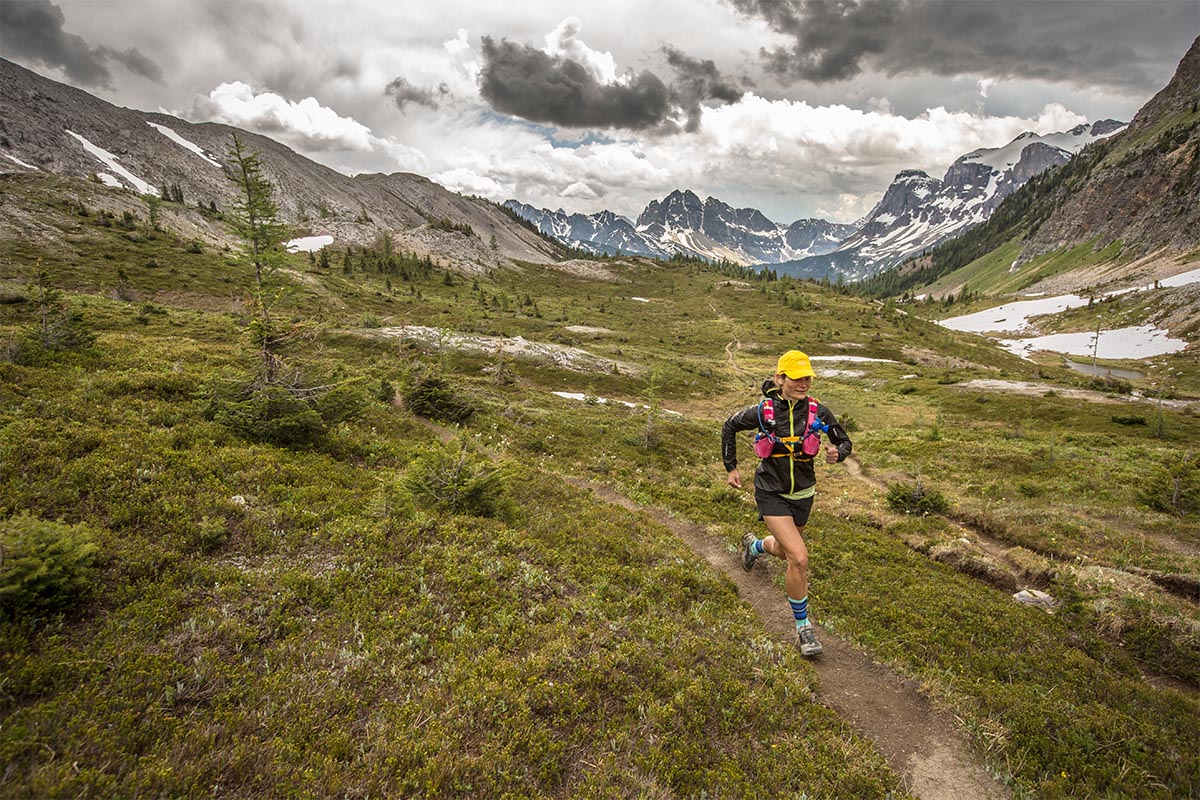
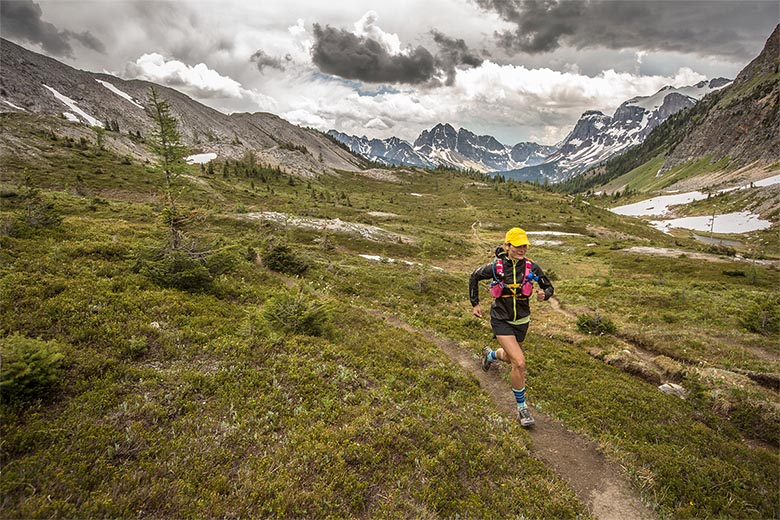
Running on varied and challenging trails is a welcome break from the monotony of pounding pavement (or even worse, the belt of a treadmill). Better yet, trail running is an immensely easy sport to get into and requires only minimal gear. Our team has clocked endless miles in just as many shoes to bring you our 18 favorites below, which cover everything from flexible and lightweight shoes for smooth trails to rugged designs for tackling technical, mountainous terrain. Whatever your speed, there's a shoe here for you. For more background information, check out our comparison table and buying advice below the picks, along with details about our testing process.
Editor's note: We updated this guide on July 10, 2025, to add the Salomon S/Lab Pulsar 4 and Saucony Peregrine 15 as two of our top shoes. We also removed the discontinued Salomon Sense Ride 5, updated the Topo Athletic Mtn Racer and Salomon Ultra to their newest models, and swapped out the On Cloudultra 2 for the Cloudultra Pro. Additionally, we updated the rankings to reflect this season's testing and added new photos from recent trail runs. Finally, we swept the guide to ensure all other information was current at the time of publishing.
 Weight: 1 lb. 1.6 oz. (unisex)
Weight: 1 lb. 1.6 oz. (unisex)
Cushioning: Moderate/high
Drop: 6mm
What we like: A nimble, performance-oriented shoe with a locked-in fit and excellent traction.
What we don’t: Expensive; runs a little long.
The Salomon S/Lab Pulsar 4 blew us away this year with its agile footing, excellent traction, and lightweight, breathable build. Built as a performance shoe in conjunction with Salomon athletes, the Pulsar 4 is the trail runner we reach for when we want to tackle long miles on technical terrain. This is an incredibly secure, reliable shoe that feels stable from ankle collar to platform, and has a close fit that moves with our feet without feeling pinched. The tongue doesn't shift, and the ankle cutouts are just deep enough to prevent bruising, while still high enough for a locked-in fit with ankle support. The Pulsar has a fairly lean upper without any overlays (keeping the weight low and the fit sleek), but the angled side shank helps maintain anterior stability on off-camber trails, something other lightweight shoes lack.
The trick is getting this shoe to fit correctly. The Pulsar 4 feels incredibly secure and comfortable, but our testers had trouble getting the correct sizing for this unisex model, and both ended up dropping down a half size. Aside from the eye-watering $220 price tag, the fit issues were our only issue with the Pulsar 4. But if you're willing to shell out money for an incredibly precise, high-performing shoe, we trust this one on everything from shale-covered trails to steep dirt mountainsides. It's light, airy, incredibly responsive, has excellent traction, and is absolutely dialed once you figure out the sizing.
Read more: Salomon S/Lab Pulsar 4 review
See the Unisex Salomon S/Lab Pulsar 4

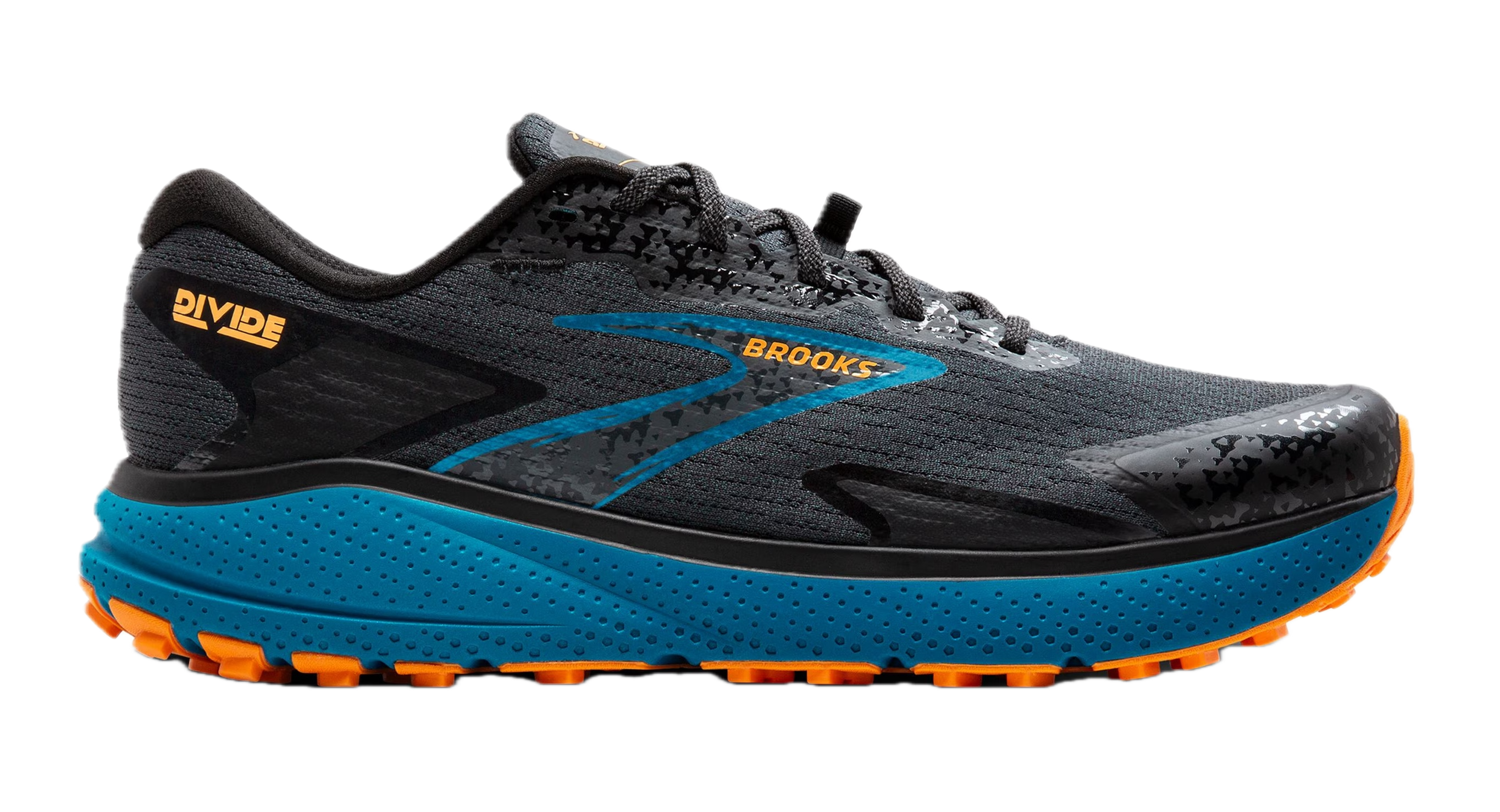 Weight: 1 lb. 5 oz. (men's), 1 lb. 1.8 oz. (women's)
Weight: 1 lb. 5 oz. (men's), 1 lb. 1.8 oz. (women's)
Cushioning: Moderate
Drop: 8mm
What we like: Nice go-between for trail and road; great price; excellent breathability.
What we don’t: On the bulkier and stiffer side; not super peppy for fast runs.
The Brooks Divide 5 is an approachable and affordable shoe at just $110, but it punches above its weight class. Marketed as a road/trail hybrid, the Divide has performed admirably for us on every surface, though it excels on moderate trails. The 25% recycled TrailTack Green outsoles expertly handle steep slopes on loose dirt and gravel, and the grip on slick rocks makes stream crossings easier and decidedly less nerve-wracking. The 5 has a slipper-like feel and impressive breathability, and despite the .6-ounce gain over the 4, it is still mid-range for trail shoe weight. It has a road-type fit with moderate 3mm lugs, and the upper is made from an air mesh that breathes like a performance road shoe.
The Divide can feel a bit clunky on roads, but as a transitional shoe for varied terrain, it is more than adequate. That said, while it handles slower paces like a dream, it struggles when trying to pick up speed—it isn't the kick to choose to try to PR your next 5K. Additionally, if you are a more advanced runner, the lack of feeling on technical terrain and the inability to work up speed will be the biggest detractors. But for those newer to trail running or who prefer less technical trails, the Divide 5 does everything it sets out to do. This is a versatile shoe that feels tacky on trails but isn't overkill for roads, and as far as trail shoes go, it's really the only more affordable option we trust. The updated Divide 6 will be available later this summer, and we will update this listing at that point.
See the Men's Brooks Divide 5 See the Women's Brooks Divide 5
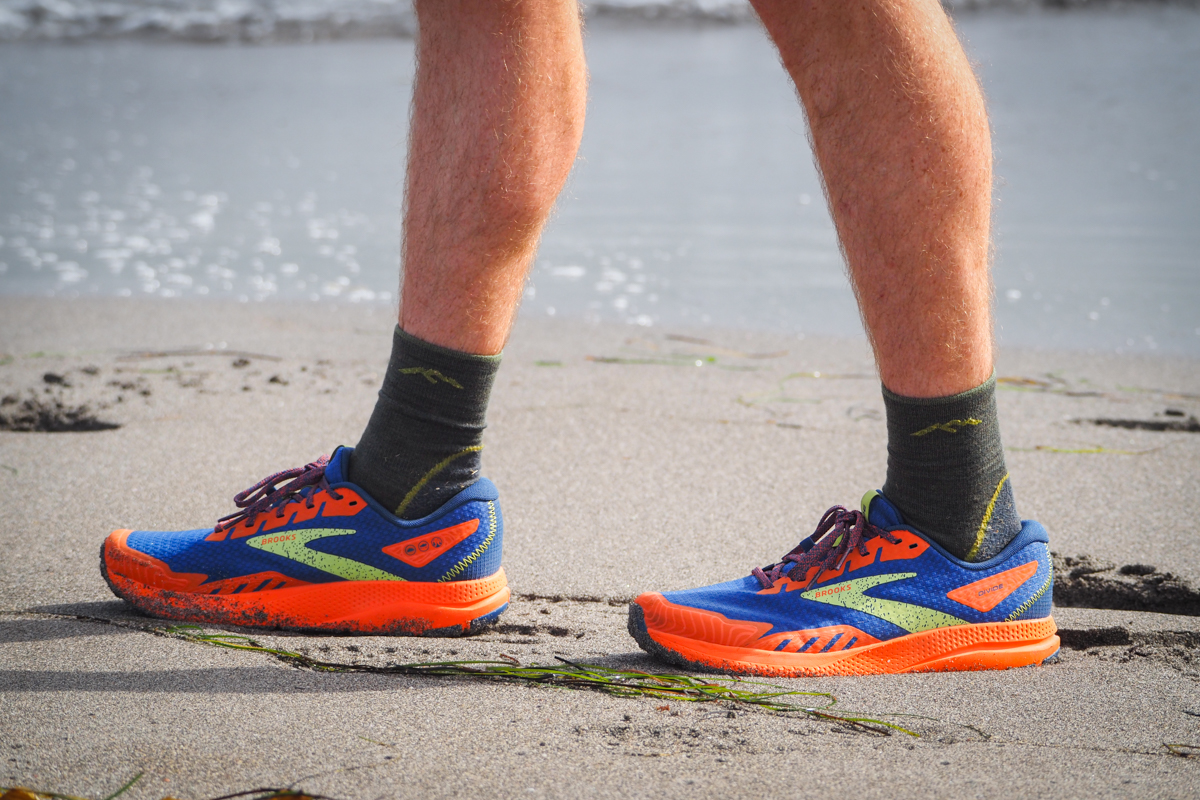
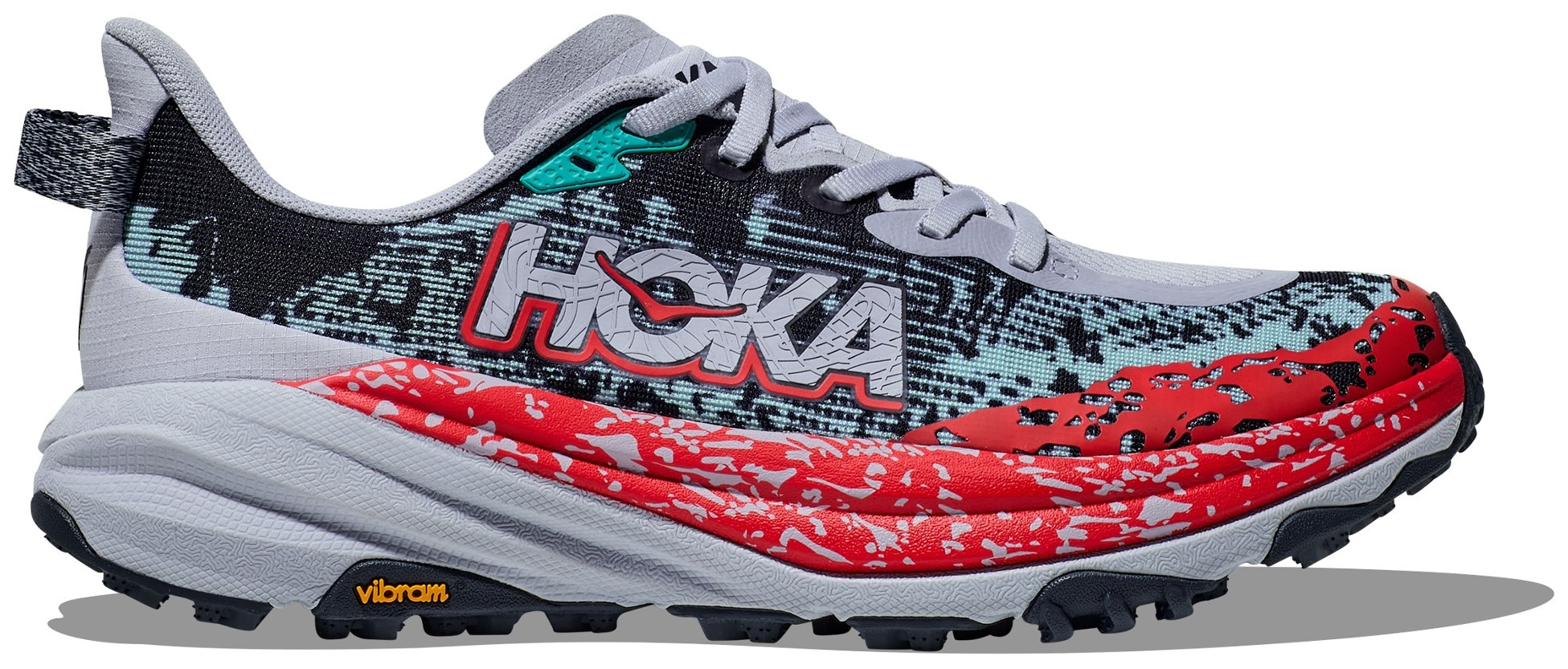 Weight: 1 lb. 3.6 oz. (men's), 1 lb. 0.4 oz. (women's)
Weight: 1 lb. 3.6 oz. (men's), 1 lb. 0.4 oz. (women's)
Cushioning: Maximum
Drop: 5mm
What we like: Standout comfort and traction in a lightweight package.
What we don’t: Thick midsole minimizes trail feel in technical sections; we liked prior versions better.
Hoka has built their reputation around plush, heavily cushioned running shoes, and the latest Speedgoat 6 is a nice upgrade to the popular design. With a thick midsole (40mm at the heel), the shoe offers maximum long-distance comfort and underfoot protection, absorbing a nice amount of impact with each stride. But there’s a lot more to love about the design: In our opinion, the Speedgoat hits a near-ideal balance of comfort, weight, protection, and responsiveness, whether you’re running short or far, fast or slow. The aggressive outsole is light but sticky with substantial lugs (improved from previous editions), blown rubber, and a Vibram Megagrip compound that holds well on everything from dry dirt and mud to steep rock. Tack on a medium-width toe box that fits a broad range of foot shapes, and it’s no secret why the Speedgoat has garnered such popularity over the years.
However, while the latest Speedgoat offers better stability and durability than previous models, it comes at the cost of less cushion and "spring"—one of the primary reasons many turn to Hoka. We've also found the 6 to be a bit more narrow (especially around the toe box) and less breathable due to its more abrasion-resistant materials. Finally, we wish the tongue were a little longer—we didn't have this issue with the 5, but the tongue on our 6 barely extends past the laces and can get sucked partway underneath if you're not careful. On a fun note, Hoka knows that some recent Speedgoat updates weren't a fan favorite, so in a rare industry decision, they rereleased the iconic Speedgoat 2 for a limited time, including the past version's fit, materials, colorways, and particularly secure locked-in feel we loved a few years back. Read our review of the beloved rereleased Speedgoat 2 here.
Read more: Hoka Speedgoat 6 review (women's version)
See the Men's Hoka Speedgoat 6 See the Women's Hoka Speedgoat 6
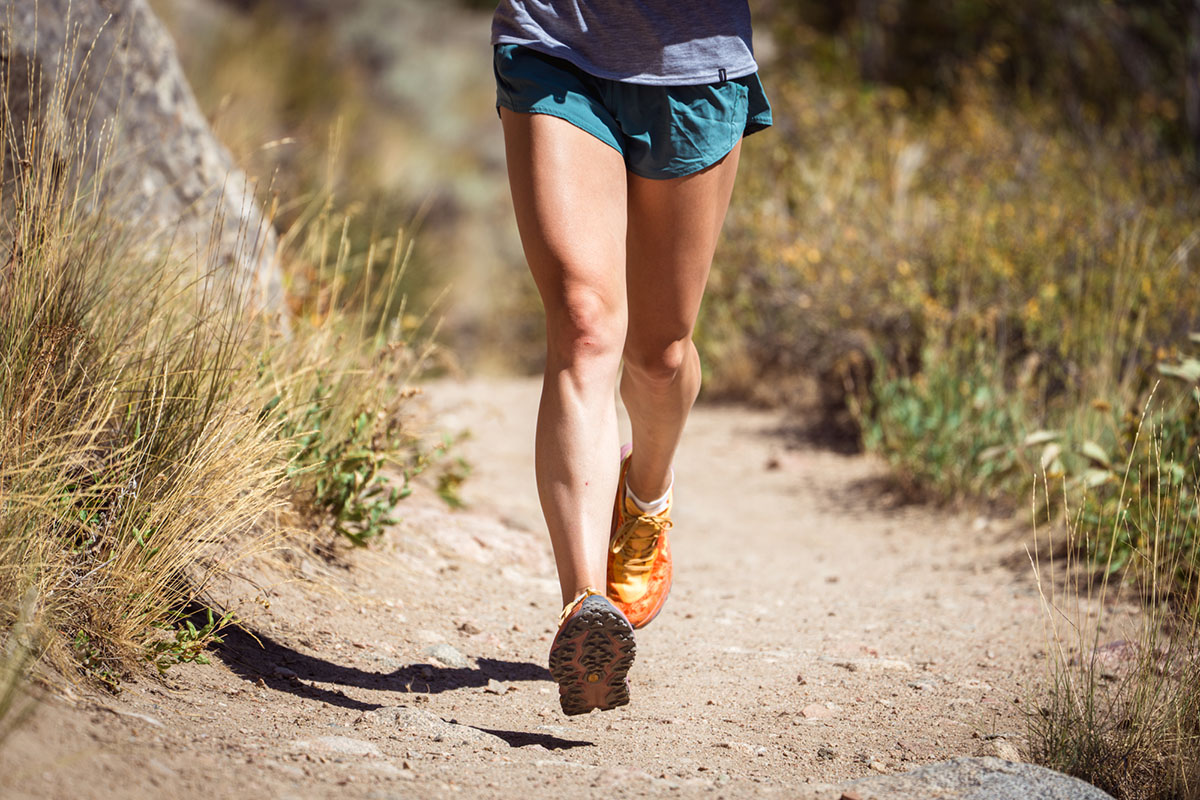
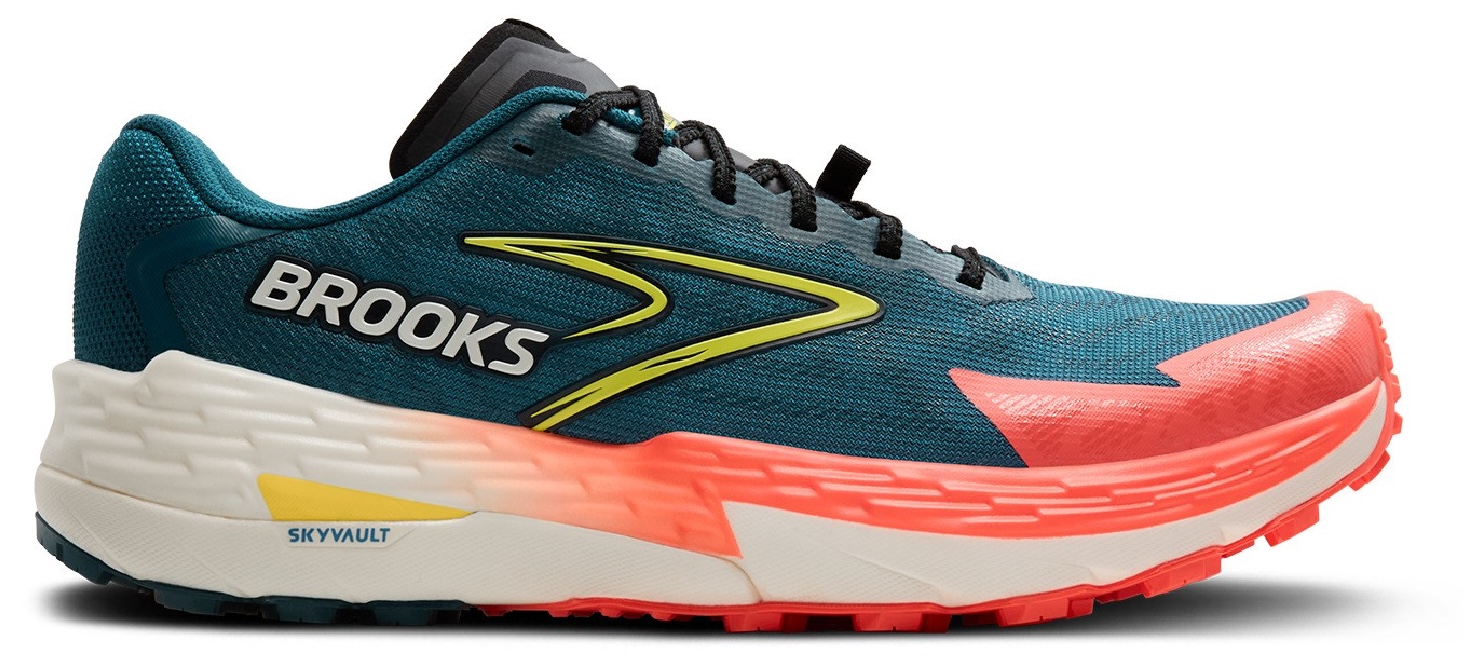 Weight: 1 lb. 3.0 oz. (men's), 1 lb. 1.0 oz. (women's)
Weight: 1 lb. 3.0 oz. (men's), 1 lb. 1.0 oz. (women's)
Cushioning: Moderate
Drop: 6mm
What we like: A lightweight shoe that can tackle both easy and technical trails at speed.
What we don't: Some ultra-distance runners will want a bit more cushion and support.
Brooks is best known in the trail running world for their Cascadia (below), a shoe beloved amongst both runners and thru-hikers. But the modernized Catamount 4 offers a lighter and more nimble take, built to tackle moderate distances at speed. Imported from Brooks’ Hyperion Tempo road shoe, the carbon-like DNA Flash v2 midsole is lightweight and responsive, offering a snappy underfoot feel ideal for pushing the pace and precision on tricky sections of trail. Another highlight is the SkyVault v2 propulsion plate, which protects your feet from rocks and boosts efficiency on the uphill. Whether you’re cruising gravel roads or going to battle on technical terrain, the Catamount is one speedy shoe to have on your team.
With last years revamp, the Catamount 4 adds a little weight to the prior version (0.2 oz. per pair) while also incorporating more recycled materials from previous iterations. Brooks also tweaked the fit of the upper for added comfort over long distances, although we'd still recommend sticking to about 50K or less at a time since these shoes have less padding than burlier models. But the Catamount hits a versatile middle ground between speed-oriented shoes like the Hoka Torrent 4 (below) and more rugged trail runners. You get a more substantial outsole than the Torrent for better performance on technical trails, but a zippier and more locked-in feel than a bulkier model like the Brooks Cascadia. For a high-performance, race-day-oriented shoe that can do it all, this is a solid option.
See the Men's Brooks Catamount 4 See the Women's Brooks Catamount 4

 Weight: 1 lb. 3.4 oz. (men's), 1 lb. 1.2 oz (women's)
Weight: 1 lb. 3.4 oz. (men's), 1 lb. 1.2 oz (women's)
Cushioning: Moderate
Drop: 4mm
What we like: Updated fit is secure without constriction; excellent heel lock.
What we don’t: The 28/24mm cushion might not be enough for runners used to a max-cushioned shoe.
The Peregrine is Saucony's most popular and versatile trail shoe, and recent updates shot the 15 into our top picks this year. The forefoot and toe box have a secure, accurate fit without constriction, and the heel lock is excellent even on tight corners and bouncy descents. The updated outsole rubber kept us stable on everything from loose, slippery rocks to soft dirt and stayed secure when the going got wet. The 4-millimeter drop is subtle enough to promote forward propulsion without losing your natural stride, and the fit is confidence-inspiring without an aggressively tight wrap. We found the mesh upper to be both breathable and abrasion resistant, and the shoe is responsive over long distances thanks to Saucony's medium-density Pwrrun foam we love from their road-running shoes.
We really don't have many gripes with the comfort, fit, and performance of the newest Peregrine. This is an incredibly versatile shoe for everything from longer days to run-hike combos, and it still feels peppy and responsive during faster runs on gravel or moderate trails. If anything, competitive trail runners might want a more specialized shoe like the La Sportiva Bushido below, and ultrarunners might prefer more cushion than the Peregrine's 28-millimeter heel stack. But the recent fit updates solved our tight forefoot issues, and the shoe's locked-in feel, stable traction, and reasonable price are hard to beat. If anything, we recommend wearing a sock with at least a 3-inch cuff, as the Peregrine's heel tab is a little tall and can rub with shorter socks.
See the Men's Saucony Peregrine 15 See the Saucony Women's Peregrine 15

 Weight: 1 lb. 6.4 oz. (men's), 1 lb. 2.6 oz (women's)
Weight: 1 lb. 6.4 oz. (men's), 1 lb. 2.6 oz (women's)
Cushioning: Moderate
Drop: 0mm
What we like: A very comfortable shoe that allows the foot to lie in its natural position; lighter than the prior version.
What we don’t: Sluggish, slipper-like feel; too roomy for some.
If you’re among the myriad trail runners who suffer from pressure points, hot spots, and blisters resulting from ill-fitting shoes, this one’s for you. Popularized by the barefoot running movement, Altra’s zero-drop Lone Peak is one of the most ergonomic and comfortable trail runners on the market. With a flat footbed and extra roomy toe box, the Lone Peak allows the foot to lie in its naturally prone and splayed position, which is great news for wide-footed runners or those with particularly finicky feet. We’ve recommended this shoe to dozens of friends and acquaintances who’ve struck out with more traditional shoes (including wide versions of models like the Hoka Speedgoat above) and have yet to lead anyone astray.
For the latest iteration, Altra added a more durable and abrasion-resistant ripstop mesh upper, gave the shoe a boost in traction with an upgraded MaxTrac outsole, and revamped the midsole for added comfort and connectedness to the ground. They also rolled out a Lone Peak 9+, which includes a Vibram outsole for $15 more. True to its trail-worthy intentions, the Lone Peak retains a rock plate and gaiter attachments. That said, the zero-drop design isn't for everyone, and those accustomed to a more traditional trail runner might find the Lone Peak sluggish, under-cushioned (you get just 25mm in the midsole), and lacking in arch support. It can feel a little dead during faster runs, and the rubber on the standard model still wears out much faster than we'd like. But there’s a reason the Lone Peak has such a loyal following, especially among fast-and-light hikers.
Read more: Altra Lone Peak 8 review (men's version)
See the Men's Altra Lone Peak 9 See the Women's Altra Lone Peak 9

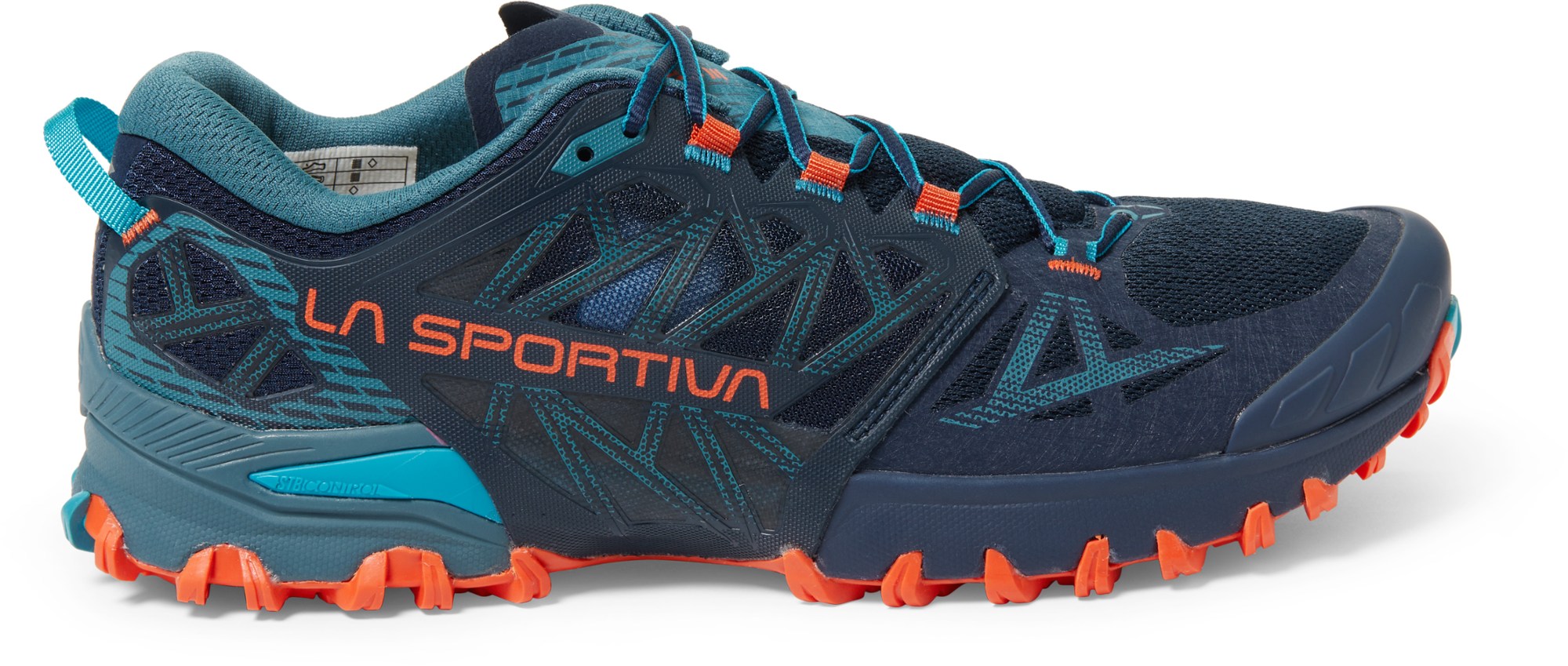 Weight: 1 lb. 5.2 oz. (men's), 1 lb. 1.6 oz (women's)
Weight: 1 lb. 5.2 oz. (men's), 1 lb. 1.6 oz (women's)
Cushioning: Light/moderate
Drop: 6mm
What we like: A superb technical shoe with awesome traction.
What we don’t: Too much grip and not enough cushion for high-mileage outings and daily training.
Today's mountain athletes don’t think twice about taking on technical challenges with nothing more than a pair of running shoes and a day’s worth of supplies, and many of our go-to shoes come from climbing specialist La Sportiva. Their versatile Bushido III is a perennial favorite and excels on all manner of terrain, from soggy trails and snow to fifth-class rock and loose talus. Grippy FriXion rubber (a compound used on some of La Sportiva’s climbing shoes) gives you solid traction while scrambling, and the burly tread grips remarkably well on soft terrain without being too overbuilt for firm ground. Tack on a durable upper (made more breathable with the latest update), protective toe cap, and rock guard under the forefoot, and the Bushido is a solid and confidence-inspiring workhorse of a shoe.
Compared to the Speedcross 6 below, the Bushido III has more versatile intentions for a variety of on- and off-trail terrain. Further, mountain runners will love the shoe’s low stack height (19mm in the heel compared to the Speedcross’s 32mm), which lends stability and a solid ground feel. But all this performance does end up feeling a bit overkill on smooth paths, and the Bushido’s lightly cushioned midsole is noticeably less comfortable than all-around models like the Speedgoat or Pulsar 4 above, especially on high-mileage days. Still, for technical missions that demand high precision and reliable grip, the Bushido is hard to beat.
Read more: La Sportiva Bushido III review (women's version)
See the Men's La Sportiva Bushido III See the Women's La Sportiva Bushido III
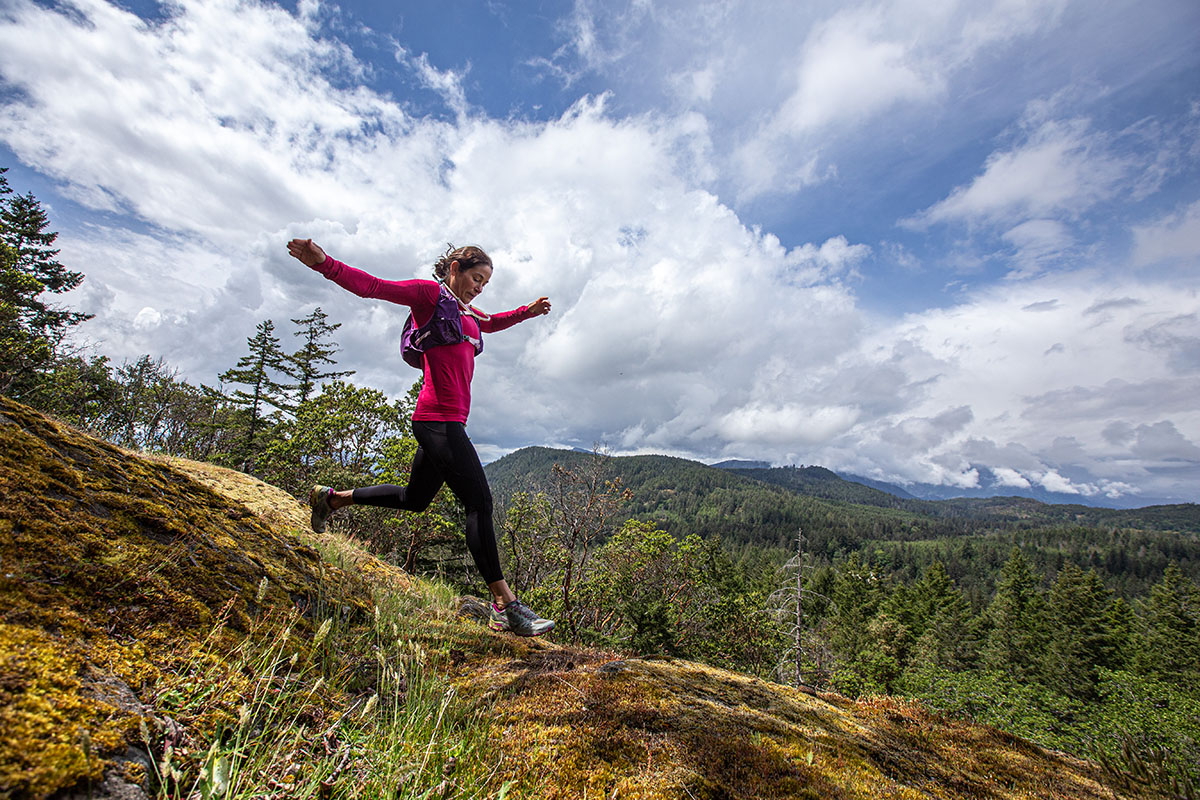
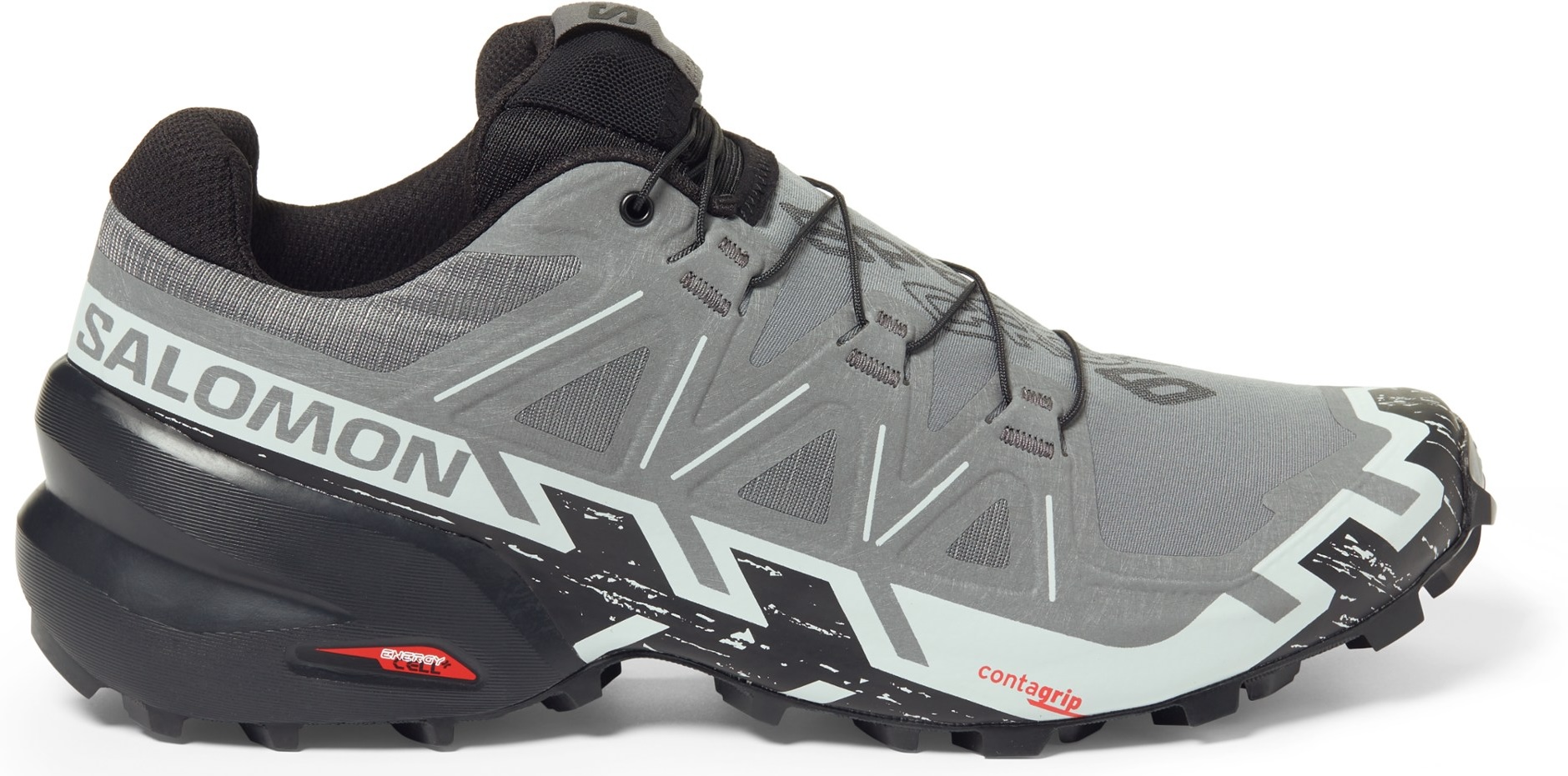 Weight: 1 lb. 5.0 oz. (men's), 1 lb. 2.5 oz. (women's)
Weight: 1 lb. 5.0 oz. (men's), 1 lb. 2.5 oz. (women's)
Cushioning: Moderate
Drop: 10mm
What we like: Truly excellent traction on soft ground.
What we don’t: Not versatile for easy trails or most mountain running.
When it comes to soft terrain like mud and snow, you'll want a full rubber outsole like the Salomon Speedcross. With relatively long and widely spaced lugs, this shoe bites into the ground with each step and feels more secure than trail runners with a combo of foam and rubber on the outsole. The trail-eating Speedcross 6 sets the standard in this category, combining 5-millimeter arrow-shaped lugs and a supportive and snug-fitting upper for impressive control at speed. Tack on a stiff midsole, single-pull lace system, and sturdy-yet-reasonably light chassis, and you get one of the most capable trail designs, whether your run takes you over snow, sand, or wet leaves and thick mud.
The latest Speedcross features a revamped upper and outsole at slightly lower weight than its predecessor. This design feels the most well-rounded of all the past models—you don’t get that tippy feeling we’ve found with previous versions, and the shoe holds its own on short stretches of pavement. That said, the Speedcross is by no means a generalist, and most runners will find its tooth-like lugs and aggressive build to be overkill on easy trails and gravel roads. The stiff underfoot feel dropped it down a few slots this year, and the shoe lacks the cushioned rebound we've become accustomed to with today's trail shoes. But for wet and rugged forest paths, the Speedcross 6 is incredibly purpose-built, even down to details like the anti-debris mesh upper and gusseted tongue.
Read more: Salomon Speedcross 6 review
See the Men's Salomon Speedcross 6 See the Women's Salomon Speedcross 6
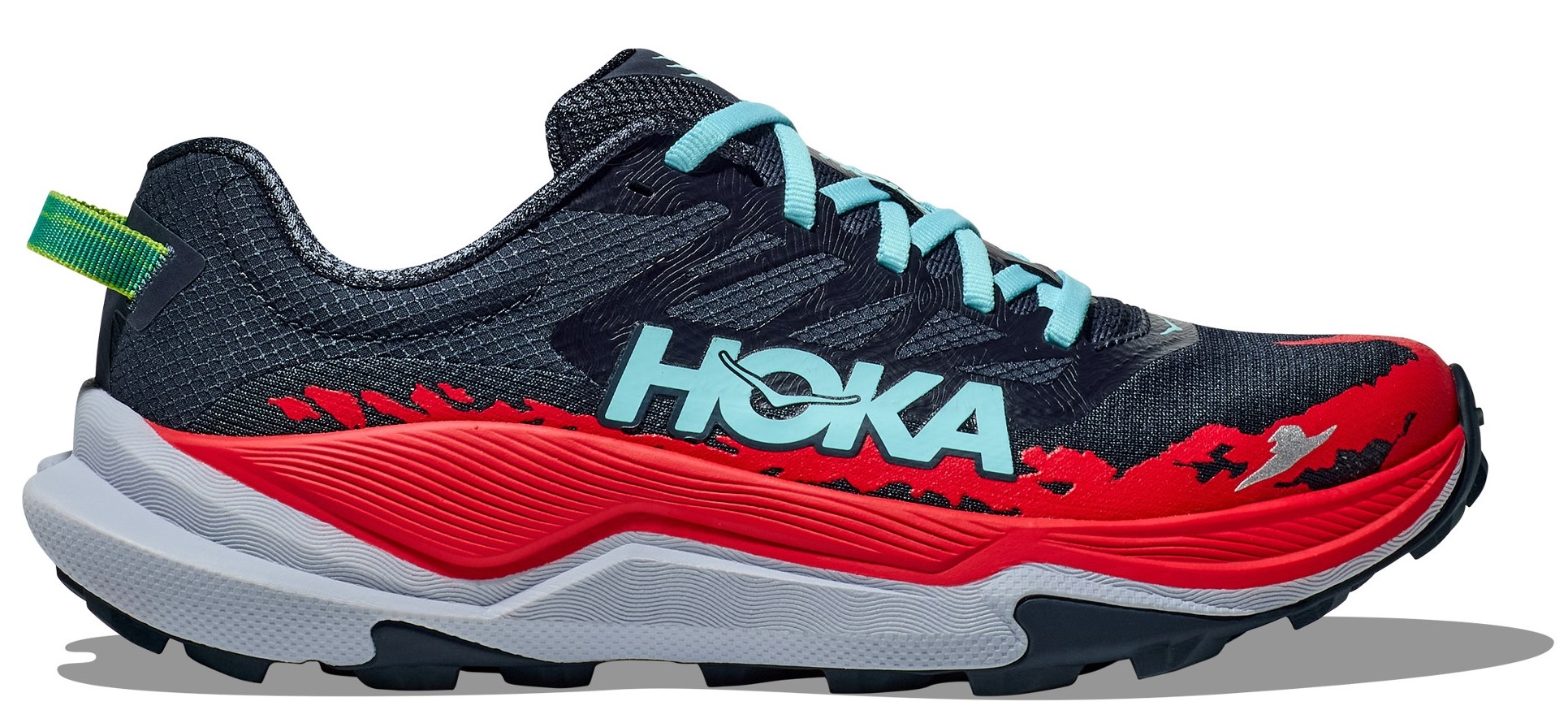 Weight: 1 lb. 3.6 oz. (men's), 1 lb. 1.0 oz. (women's)
Weight: 1 lb. 3.6 oz. (men's), 1 lb. 1.0 oz. (women's)
Cushioning: Moderate
Drop: 5mm
What we like: The plushness of a Hoka, yet responsive and nimble; great grip.
What we don’t: Light cushioning is not ideal for high-mileage days; lacks the locked-in feel of most minimalist race shoes.
Running-shoe giant Hoka has built a name around their max-cushioned designs (as seen in the Speedgoat above), but the Torrent 4 bucks this trend with a lower profile that provides ample ground feel. It also features a single-layer mesh upper that’s both lightweight and breathable. The result is a responsive, agile Hoka that’s built for speed, making it great for race days and tempo workouts. And with Hoka’s proprietary sticky rubber sole and 5-millimeter multi-directional lugs (a bump up from the Torrent 3’s 4mm lugs), it also holds its own on technical trails. We put over 300 miles into the past-generation model and came away impressed with its nimble yet plush feel combined with great traction on a variety of terrain.
Despite its Hoka heritage, the Torrent 4 won’t be the shoe most runners choose for long-distance efforts over 50 miles. In fact, we discovered this firsthand during a 100-mile race in the past generation 3: By mile 45, the combination of rocky terrain, streamlined cushioning, and air channels in the insole led to blisters on the bottom of both feet—a first-time experience for us despite years of long-distance running. At the same time, the Torrent 4 lacks the locked-in feel we'd want for racing sub-ultra distances at speed. That said, it's nevertheless a likable design for daily training runs and long-ish efforts on easy trails, and it doesn't hurt that it's one of the most affordable trail shoes here at just $130. Overall, while there are grippier shoes (anything with Salomon's Contagrip or Vibram’s Megagrip rubber) and plusher shoes (Hoka Speedgoat), the Torrent puts it together better than most, making it one of our go-to designs in Hoka’s lineup.
See the Men's Hoka Torrent 4 See the Women's Hoka Torrent 4
 Weight: 1 lb. 5.8 oz. (unisex)
Weight: 1 lb. 5.8 oz. (unisex)
Cushioning: Maximum
Drop: 8mm
What we like: Salomon's most premium ultra-distance design; excellent traction on fast descents.
What we don’t: Expensive; lacks stability in the upper.
Salomon’s S/Lab series is home to their most innovative and high-performance footwear, and the recently updated Ultra is the long-distance specialist. The shoe exudes premium quality from heel to toe and is a noticeable step up from the Speedcross and XA Pro line. The recent update increased material layering through the upper, which added several ounces but also bumped durability. The fit on the Ultra is great too—it has a sleek, sock-like feel that requires no adjustments, even on trails with jarring downhill sections. As far as traction goes, we were skeptical of the shallower 3.5-millimeter lugs, but ended up impressed with both their grip and nimble feel. The Contagrip rubber compound is quite tacky, adding security to rock slabs, though the shoes didn't perform as well on wet surfaces.
The Ultras aren't perfect though, and the heel counter has so little structure that it folds and buckles no matter how carefully we slide our feet in. Additionally, while the slipper-like fit offers long-distance comfort, we felt less stable through the upper, especially compared to the close-fitting structure of the Pulsar 4 above. But the taller cushion does help absorb bumps on uneven ground, and the platform offers a secure foot plant. Overall, for experienced ultra runners wanting to get the most out of their shoe, the S/Lab Ultra is a proven and capable option vetted by pros like Courtney Dauwalter and François d’Haene.
See the Salomon S/Lab Ultra
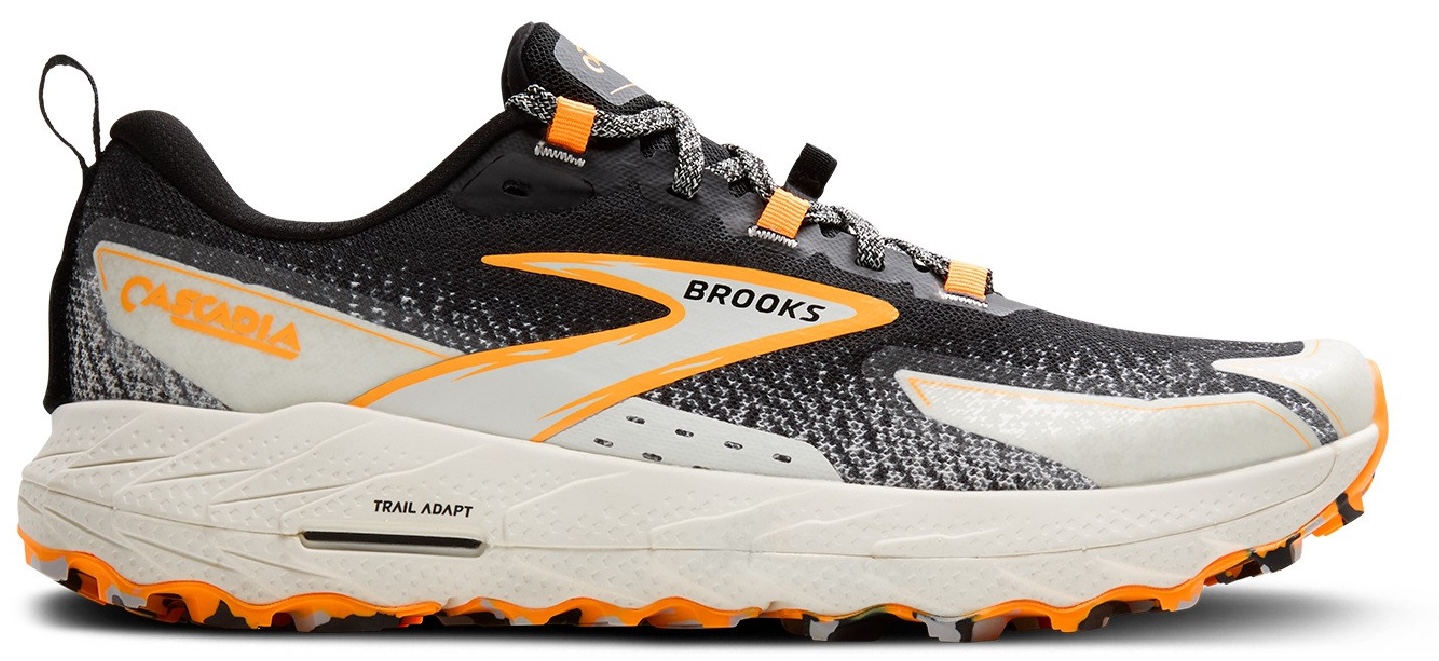 Weight: 1 lb. 6.2 oz. (men's), 1 lb. 3.8 oz. (women's)
Weight: 1 lb. 6.2 oz. (men's), 1 lb. 3.8 oz. (women's)
Cushioning: Moderate
Drop: 8mm
What we like: A wonderfully comfortable and protective shoe for technical terrain.
What we don't: A bit too stiff and heavy to be a daily trainer.
Now in its 18th iteration, the Brooks Cascadia is one of the longest-standing trail runners on the market, and for good reason. This is a shoe that can do it all, with the traction and protection you need for rugged trails alongside a hefty dose of cushioning for long days out. Add to that a roomy toe box and an emphasis on stability, and the Cascadia is an easy-wearing shoe that's deservingly popular among a wide audience, from ultrarunners and daily joggers to mile-crunching thru-hikers (it’s gaiter-compatible, too). All told, it’s a workhorse shoe that will put a bounce in your step, which is never a bad combination.
The Cascadia 18 remains similar to its predecessor in most respects, with the notable addition of a quick-drying mesh upper and overlays in high-wear areas to help improve durability. And despite the shoe’s wide base and all-terrain-vehicle feel, we’ve found it to be more precise than the boat-like Speedgoat above, even while traversing off-camber terrain. Of course, the Cascadia still can’t match the speed or light weight of some of the top models here, and we think it’s a bit overkill for a daily trainer (the 18 is nearly an ounce heavier per pair than previous models). But for a trail shoe that will provide reliable stability and protection mile after mile—and double as a capable hiking shoe—the Cascadia remains one of the best all-rounders in the game. The updated Cascadia 19 will be available very soon, and we will update this listing upon release.
See the Men's Brooks Cascadia 18 See the Women's Brooks Cascadia 18
 Weight: 1 lb. 6.6 oz. (men's), 1 lb. 2.6 oz. (women's)
Weight: 1 lb. 6.6 oz. (men's), 1 lb. 2.6 oz. (women's)
Cushioning: Maximum
Drop: 4mm
What we like: Plush cushioning and reliable grip for logging serious miles in the mountains.
What we don't: Relatively heavy and expensive; we have mixed feelings about the built-in ankle gaiter.
Nike has put some serious R&D into their trail shoe lineup, and sitting at the top is their Zegama 2. Nike markets the shoe for endurance purposes, with a thick and responsive midsole that gives max-cushion competitors like the Hoka Speedgoat above a run for their money. We also love the Vibram Megagrip outsole, which features a series of multi-directional, V-shaped lugs that provide reliable grip on everything from loose dirt to smooth rock. And the 4-millimeter drop strikes a nice middle ground—especially compared to the Nike Wildhorse, which has a much more dramatic 9.5-millimeter drop.
On the trail, the Zegama 2 felt comfortable and locked-in out of the box. Our tester, who has blister-prone heels, didn’t experience any discomfort on runs ranging from short loops on local trails to high summits with miles of talus-hopping and bushwhacking. One feature we aren’t sold on is the built-in ankle gaiter, which is very shallow (much smaller than Hoka’s Tecton X3) and resulted in a small gap above our heel at the start of each stride. Thankfully, this didn’t cause any friction-related problems, and the shoe did pretty well at sealing out small rocks and other trail debris. While not perfect, we came to appreciate the upgrade in protection compared to standard trail shoes. All in all, if you’re sold on a max-cushion design but want to retain as much technical prowess as possible, we really like what the Zegama 2 has to offer.
See the Men's Nike Zegama 2 See the Women's Nike Zegama 2
 Weight: 1 lb. 4.8 oz. (men's), 1 lb.1 oz. (women's)
Weight: 1 lb. 4.8 oz. (men's), 1 lb.1 oz. (women's)
Cushioning: Moderate
Drop: 5mm
What we like: A wonderful all-arounder that holds up well over the long term.
What we don't: The wide toe box might be a dealbreaker for some.
Topo Athletic might not be a household name like Salomon or La Sportiva, but their lineup of trail and road running shoes speaks for itself (plus, they’re founded by the former CEO of Vibram). The Mtn Racer 4 is a standout trail-specific model in their quiver: Like the Lone Peak above, it features a wide toe box that lends all-day comfort for swollen and hard-working feet, and has become another thru-hiker favorite. But the Mtn Racer tacks on some technical chops the Lone Peak lacks, with a 5-millimeter drop, slightly firmer cushioning, a sticky Vibram Megagrip sole (a popular blend in approach shoes), and a 1.6-ounce weight decrease. Added up, it’s a great all-around kick for everything from easy to technical trails—short and fast or long and slow—and the durable build should last upwards of 500 miles.
However, the Mtn Racer isn't a perfect shoe. While Topo increased the stack height by 3 millimeters from the 2 to the 3, and updated the insole for springier rebound in the 4, we had some serious fit issues in the 3. Despite employing every lacing technique in the book, we were unable to get a solid lock at the ankle and absolutely swam around in the shoe while running on local trails. The 4 claims to have updated these issues for a more performance-oriented fit, and initial reports from users do indeed seem promising. We're just getting started testing our pair and will provide more thoughts on the success of the update once we've logged more miles.
See the Men's Topo Mtn Racer 4 See the Women's Topo Mtn Racer 4
 Weight: 1 lb. 3.4 oz. (men's), 15.6 oz. (women's)
Weight: 1 lb. 3.4 oz. (men's), 15.6 oz. (women's)
Cushioning: Maximum
Drop: 6mm
What we like: Breathable mesh upper; comfortable underfoot for long distances.
What we don't: Ridiculously expensive; instep feels unstable during sharp cornering.
Don't be fooled by the product image—the Cloudultra Pro doesn't look nearly so rockered and shapeless in real life. While we were initially skeptical of a few things here (the astronomical price being one of them), the rolling propulsion, breathable upper, and excellent cushion won us over on long trail runs. With an updated dual-density Helion Hyperfoam midsole and a unique upper weave made from TPEE and recycled polyester, these shoes are among the lightest max-cushion models on our list. These are exceptionally breathable thanks to the mesh-like upper, and the material is still quite durable despite the wider weave. Keep in mind the 6-millimeter drop is on the high end of average for trail shoes, and can take some getting used to on steep terrain, especially paired with the 38.5-millimeter heel stack.
Overall, the more complex midsole build and highly engineered upper helped these shoes replace the standard On Cloudultra this year in our testing. But these shoes don't feel quite as stable as more traditionally styled trail runners like the Salomon Speedcross above, and we felt some collapse on the instep during cornering and sharp turns. Lastly, for fans of the original, the Cloudultra 3 is available for $70 less and has a similarly cushioned midsole, though the hollowed-out design has a tendency to attract small rocks in both iterations.
See the Men's On Cloudultra Pro See the Women's On Cloudultra Pro
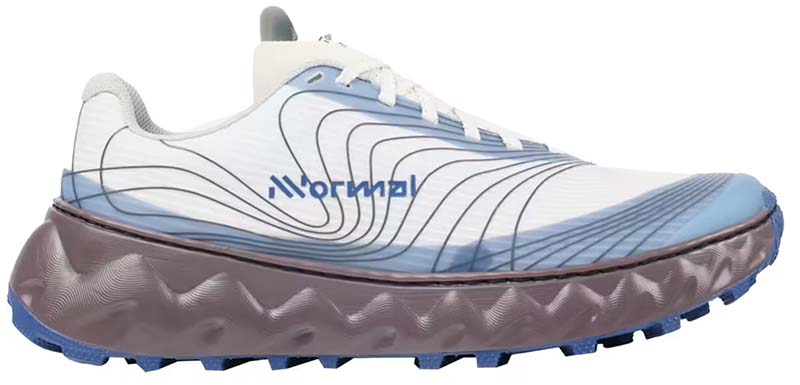 Weight: 1 lb. 4.3 oz. (unisex)
Weight: 1 lb. 4.3 oz. (unisex)
Cushioning: Maximum
Drop: 8mm
What we like: Asymmetrical lacing reduces pressure points; highly durable build.
What we don’t: Expensive; runs a little big.
If you haven’t yet heard of NNormal, allow us to introduce you: This trail-focused company was founded in the fall of 2022 as a joint venture between Camper—a family-run shoe-making business based in Mallorca, Spain—and one of the greatest mountain athletes of all time, Killian Jornet. At the time of publishing, NNormal offers a small lineup of shoes and apparel, all designed with a focus on longevity and sustainability. Killian himself raced in NNormal prototypes for the 2022 race season, allegedly wearing the same shoe for his wins at both Hardrock and UTMB. If that’s not a glowing endorsement for performance and durability, we don’t know what is.
The Tomir—updated to the 2.0 not that long ago—is NNormal’s flagship all-rounder, marketed for everything from easy trails to speed workouts and peak-bagging (for a more performance-oriented option, check out the $195 Kjerag). A few key design features help the Tomir live a long life: The upper is stitched into the midsole, asymmetrical lacing reduces pressure and wear points, and the Vibram Litebase sole has proven both rugged and durable in our testing. Other areas where the shoe stood out were comfort and responsiveness, serving as our technically savvy daily driver for over 100 miles. And to streamline the design process, the unisex fit is accommodating to most foot sizes without stepping into truly wide toe-box terrain, although those on the fence may want to size down (we did and were happy with the overall fit).
See the NNormal Tomir 2.0
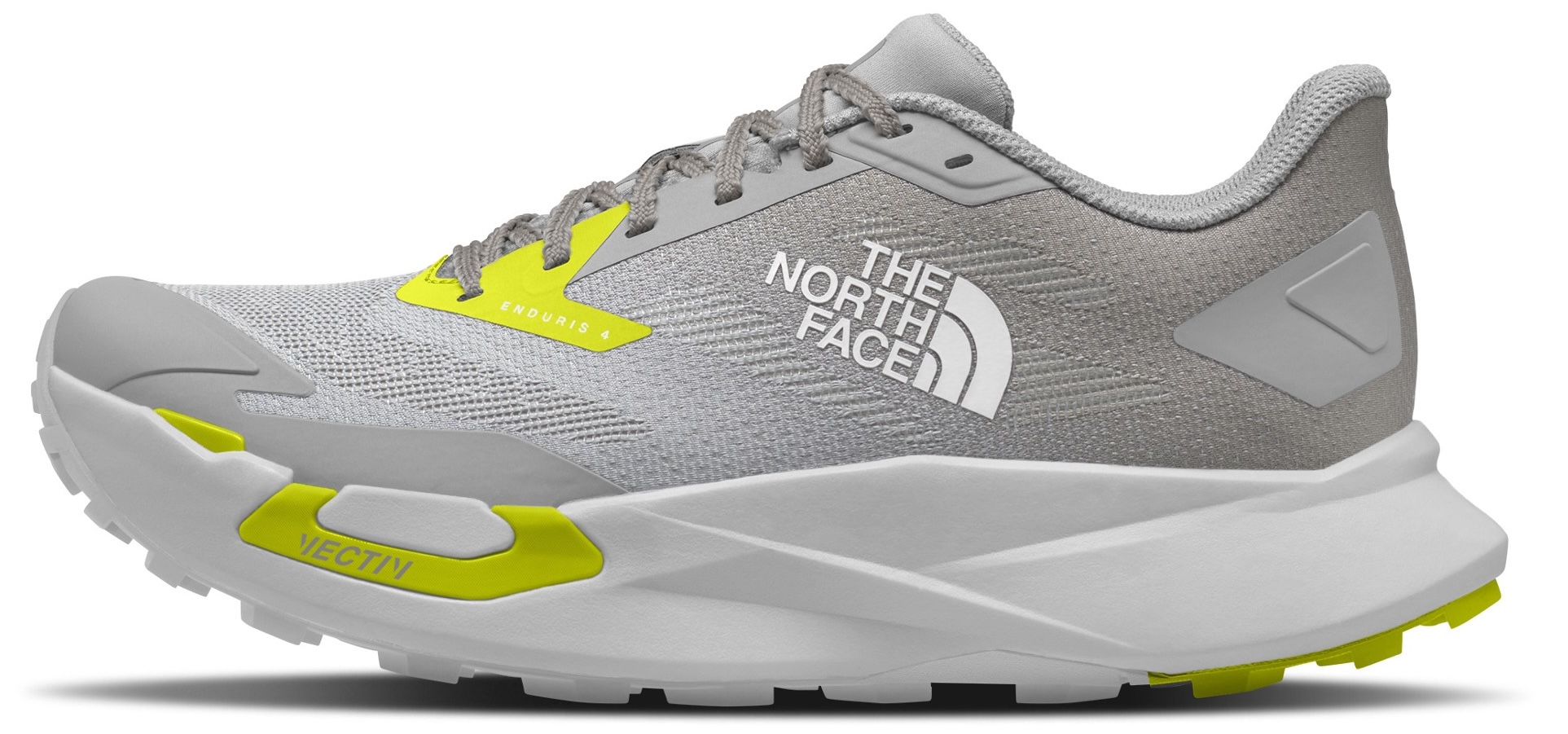 Weight: 1 lb. 4.2 oz. (men's), 1 lb. 1.9 oz. (women's)
Weight: 1 lb. 4.2 oz. (men's), 1 lb. 1.9 oz. (women's)
Cushioning: Maximum
Drop: 6mm
What we like: A reliable and comfortable daily training shoe.
What we don’t: Not particularly fast, especially compared to more high-end Vectiv offerings.
The North Face hasn’t always been much of a player in trail running, but that all changed with the release of their Vectiv lineup. The growing collection now includes a gaggle of hiking and trail running offerings with a signature rockered sole and moderate-to-maximum midsole cushioning. The Enduris 4 here is the daily trainer, providing runners a plush underfoot feel (you get 32mm of cushion in the heel—a slight bump up from the "3") and a responsive ride that’s forgiving enough to go all day. The Enduris 4 also boasts an additional 2 millimeters of midsole padding compared to the past-generation 3. Tack on an airy mesh upper, a full rubber outsole, an accommodating fit, and increased stability via the Vectiv 3.0 midsole, and the latest Enduris stands out as one of our favorite all-rounders this year.
We don’t blame you if the higher-end Vectiv Sky 2 ($200) grabs your attention over the Enduris, with flashy selling points like a carbon-fiber plate and a number of notable podiums to its name. For experienced runners, this is a great race-day shoe that offers an excellent combination of speed and stability. But the more affordable Enduris is the indisputable daily driver, with a much more forgiving feel and fit for most feet. What’s more, you can even push it off-trail thanks to the tacky SurfaceCtrl rubber—the Enduris 3 was the only shoe that fit our swollen feet during the latter half of the North Cascades High Route and got the job done on snowy, rocky, and loose terrain. All told, for a more cushioned alternative to an everyday shoe like the Sense Ride 5 above, the Enduris 4 is well deserving of a closer look.
See the Men's TNF Vectiv Enduris 4 See the Women's TNF Vectiv Enduris 4
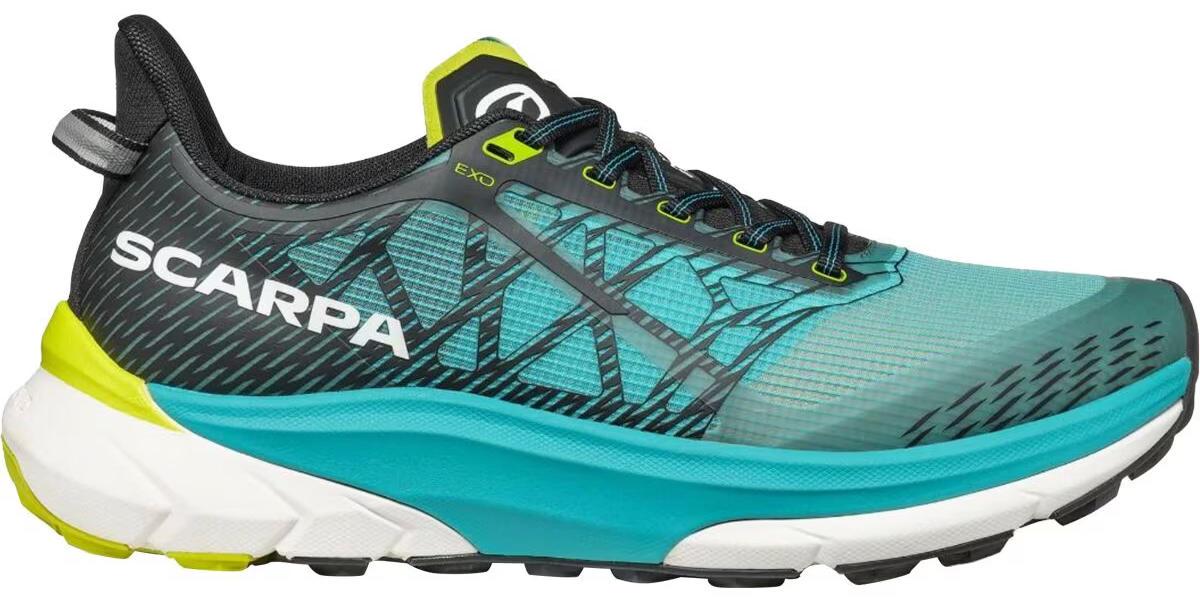 Weight: 1 lb. 2.0 oz. (men's), 15.2 oz. (women's)
Weight: 1 lb. 2.0 oz. (men's), 15.2 oz. (women's)
Cushioning: Moderate
Drop: 4mm
What we like: A lightweight road-to-trail shoe that doesn’t compromise on trail performance.
What we don’t: Not everyone will love the firm cushioning.
Unless you’re one of the chosen few who lives just steps away from singletrack, a road-to-trail shoe can be a great pairing for training runs that start out your front door. With all-terrain (ATR) in its name, Scarpa’s Golden Gate 2 ATR is a stellar choice when your route involves a mix of pavement, gravel, and trail. We love this shoe’s attention to detail, including the breathable yet thoughtfully reinforced upper and dual-density midsole that’s softer at the heel (ideal for impact absorption) and firmer at the front for great spring and propulsion. In terms of cushioning, the Golden Gate 2 ATR is Scarpa’s plushest design yet, and we think they pulled off the comfort-versus-performance balance very well.
We tested the original Golden Gate ATR on everything from 6-mile pavement loops to longer on-trail jaunts and appreciated the shoe’s high-end fit, stable feel, and subtle rocker (based on initial reviews, it’s looking like the latest 2 will have similar appeal, but we'll report back after a thorough round of testing). But while the Scarpa is designed as a road-to-trail shoe, we certainly favor it for the latter: Its cushioning is surprisingly firm (much more so than the Speedgoat above, for example), and the outsole’s 4-millimeter lugs and sticky Presa rubber are most at home on mud, dirt, rock, and snow. Of course, it’s hard to find the best of both worlds—those who prefer a plusher road feel might opt for the Nike Pegasus Trail 5 below, but you’ll give up performance on the trail. For us, the Golden Gate 2 ATR is a fairly ideal compromise, and we expect the quality construction to hold up well over time.
See the Men's Scarpa Golden Gate 2 ATR See the Women's Scarpa Golden Gate 2 ATR
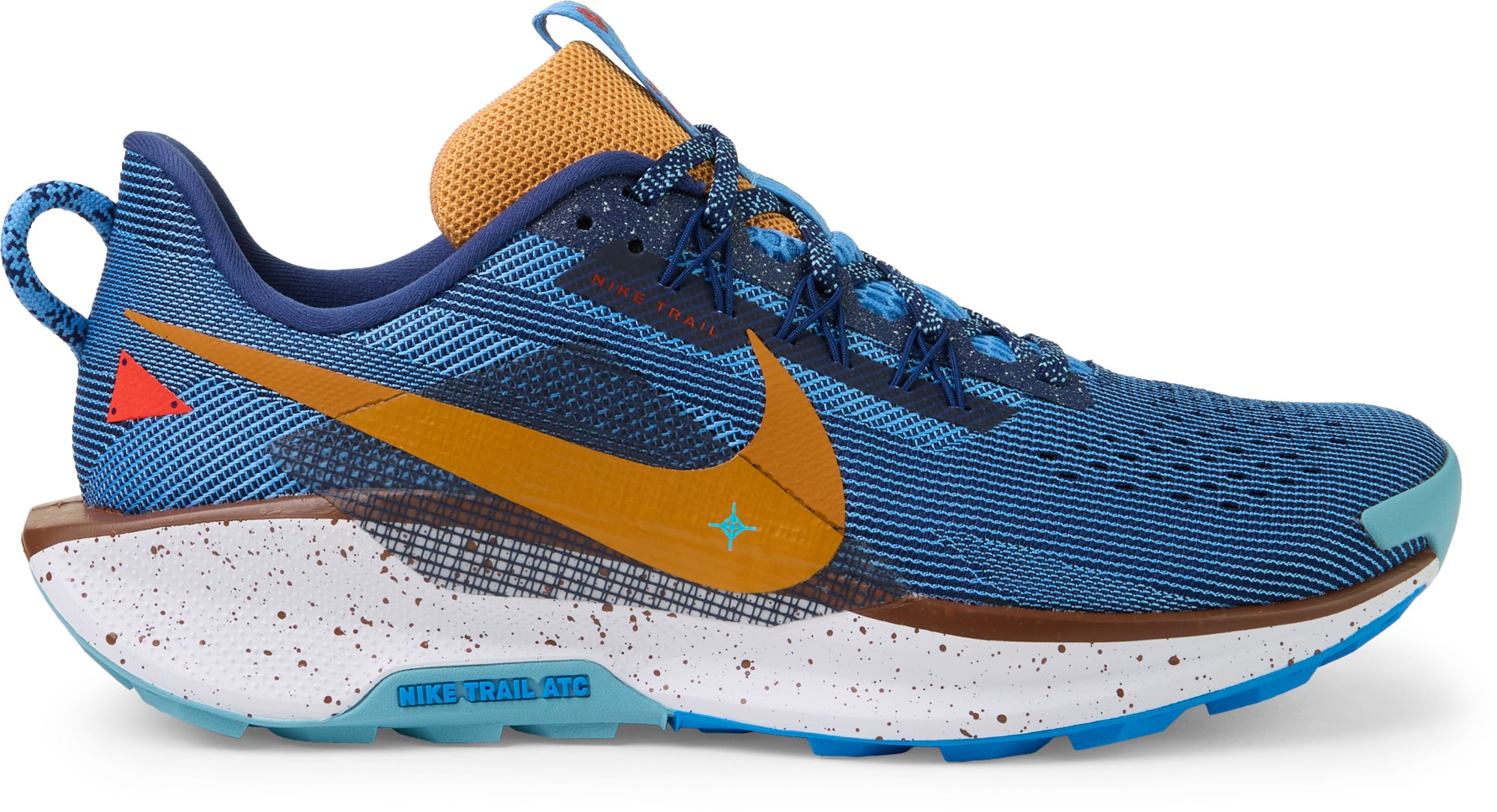 Weight: 1 lb. 4.4 oz. (men's), 1 lb. 1.2 oz. (women's)
Weight: 1 lb. 4.4 oz. (men's), 1 lb. 1.2 oz. (women's)
Cushioning: Maximum
Drop: 9.5mm
What we like: A comfortable and responsive road-to-trail shoe.
What we don’t: Unstable on technical terrain and poor traction on wet surfaces.
Nike puts most of their efforts into road running gear, but their Pegasus Trail 5 is a quality, max-cushioned option for trail work. Modeled after the road-specific Pegasus but infused with trail features (including a mostly rubber tread and reinforcements in the upper), this is one of the best road-to-trail shoes in the business. The main event here is the large dose of Nike’s soft yet responsive ReactX foam, which offers great energy return as well as long-distance comfort. You don’t get that low-slung feel that many runners love for particularly technical trails, but the Pegasus Trail 5 offers a great fit for most (with a roomier toe box than many Nike models), and the latest version is lighter than its max-cushioned frame would suggest.
Looking at Nike’s trail lineup, the Pegasus Trail is a solid all-rounder, sliding in next to the durable Wildhorse but not as rugged as the Zegama 2 above. Among the trio, the Pegasus Trail gets the edge in terms of comfort and high-mileage use, but it’s not particularly performance-oriented. The shoe’s max cushioning will feel unstable on rugged trails, and traction—although improved from the past several versions—is among the worst here, especially on wet surfaces. But for max-cushioned comfort and undeniable style, Nike’s Pegasus Trail 5 is a great option for recreational trail runners, long-distance training, and road-to-trail routes.
See the Men's Nike Pegasus Trail 5 See the Women's Nike Pegasus Trail 5
| Shoe | Price | Weight (men's) | Cushioning | Drop | Rock Plate |
|---|---|---|---|---|---|
| Salomon S/Lab Pulsar 4 | $240 | 1 lb. 1.6 oz. | Moderate/high | 6mm | No |
| Brooks Divide 5 | $110 | 1 lb. 5 oz. | Moderate | 8mm | No |
| Hoka Speedgoat 6 | $155 | 1 lb. 3.6 oz. | Maximum | 5mm | No |
| Brooks Catamount 4 | $170 | 1 lb. 3.0 oz. | Moderate | 6mm | Yes |
| Saucony Peregrine 15 | $145 | 1 lb. 3.4 oz. | Moderate | 4mm | Yes |
| Altra Lone Peak 9 | $140 | 1 lb. 6.4 oz. | Moderate | 0mm | Yes |
| La Sportiva Bushido III | $160 | 1 lb. 5.2 oz. | Light/moderate | 6mm | Yes |
| Salomon Speedcross 6 | $145 | 1 lb. 5.0 oz. | Moderate | 10mm | No |
| Hoka Torrent 4 | $130 | 1 lb. 3.6 oz. | Moderate | 5mm | No |
| Salomon S/Lab Ultra | $240 | 1 lb. 5.8 oz. | Maximum | 8mm | Yes |
| Brooks Cascadia 18 | $140 | 1 lb. 6.2 oz. | Moderate | 8mm | Yes |
| Nike Zegama 2 | $190 | 1 lb. 6.6 oz. | Maximum | 4mm | Yes |
| Topo Athletic Mtn Racer 4 | $155 | 1 lb. 4.8 oz | Moderate | 5mm | No |
| On Cloudultra Pro | $260 | 1 lb. 3.4 oz. | Maximum | 6mm | Yes |
| NNormal Tomir 2.0 | $180 | 1 lb. 4.3 oz. | Maximum | 8mm | No |
| The North Face Vectiv Enduris 4 | $160 | 1 lb. 4.2 oz. | Maximum | 6mm | No |
| Scarpa Golden Gate 2 ATR | $179 | 1 lb. 2.0 oz. | Moderate | 4mm | No |
| Nike Pegasus Trail 5 | $155 | 1 lb. 4.4 oz. | Maximum | 9.5mm | No |
The Switchback Travel team has been cruising mellow mountain singletrack and boulder-strewn trails for years. Our founding members drew from runs, races, and mountain scrambles to curate our initial round-up of 10 shoes back in 2016. Senior editor Chris Carter took over the guide in 2024 with help from testers Ben Stalheim and Sasha Brown. A dedicated ultrarunner, Chris has worn down the tread of countless trail shoes over thousands of miles and is all too familiar with the sinking feeling of uncomfortable feet mid-run. Ben is a wildlife biologist based in Florida who loves to trail run with his binoculars as a means to cover a lot of miles while birding, and Sasha is a former racer and avid trail runner in British Columbia. Contributing editor Maggie Slepian jumped on the bandwagon to help oversee this lineup in 2025, backed by more than a decade of professional shoe testing, thru-hiking, and four-season trail running in Montana, Utah, the northeast, and the West Coast.
Our current selection of 18 trail runners is a result of continued on-trail testing, along with feedback from seasoned contributors and the running community as a whole. We put trail running shoes through a variety of real-world tests—from short after-work jaunts on local trails to organized ultra-distance races—to gauge their performance. Stability, cushioning, traction, and weight are all key factors we look at when dissecting a shoe's merit, and each model has to prove itself over many miles (generally at least 50) before earning a spot on our list. Finally, as mentioned, we know that the competition for the trail shoe podium is fierce and constantly evolving. As a result, we continue to test new and noteworthy shoes as they become available, adding any standouts to our list along the way—so be sure to check in with us regularly.
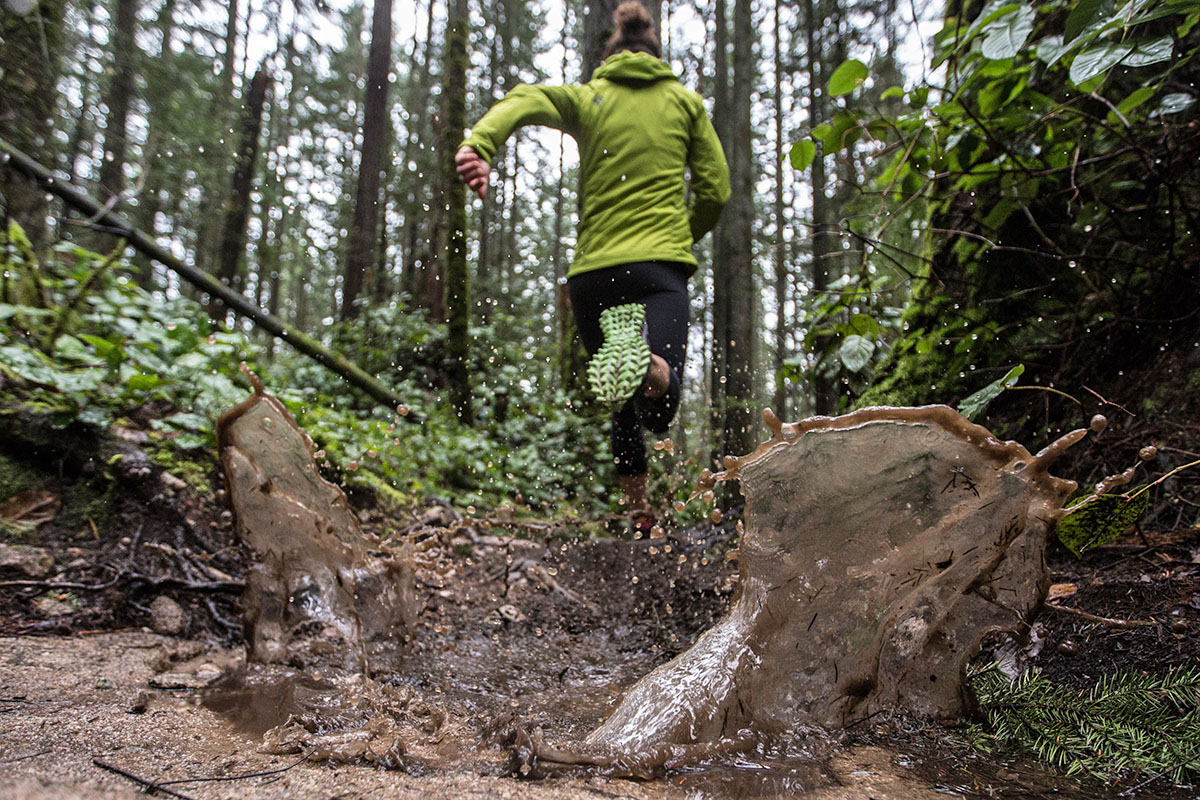
Selecting the best trail running shoe comes down to a variety of factors, including the style of running (terrain, distance, and speed) and your own preferences (feel and fit). We used to think it would be helpful to our readers to have our picks above divided into categories—a sort of “you tell us what type of trails you run, we’ll tell you what to wear.” But then we took a deeper look at our own shoe choices and realized most running shoes defy categories. It's more about the synergy between the shoes, the terrain, and the runner. However, there are still a good number of clues that can help you narrow down your choices.

Most shoes here are great all-rounders: sufficient for most runners on a range of terrain. But if you have specific demands for a shoe—like running far, fast, or remote—you'll want to look at a specialist shoe. In general, max-cushioned shoes are great for ultra distances, such as the Hoka Speedgoat 6. Runners venturing off-trail will want to prioritize protection, stability, and sticky tread as is offered in the La Sportiva Bushido III. And for going fast, look for a locked-in shoe with a sleeker design like the Salomon S/Lab Pulsar 4. Most runners find a shoe (or shoes) that they love and just stick with it, year after year.
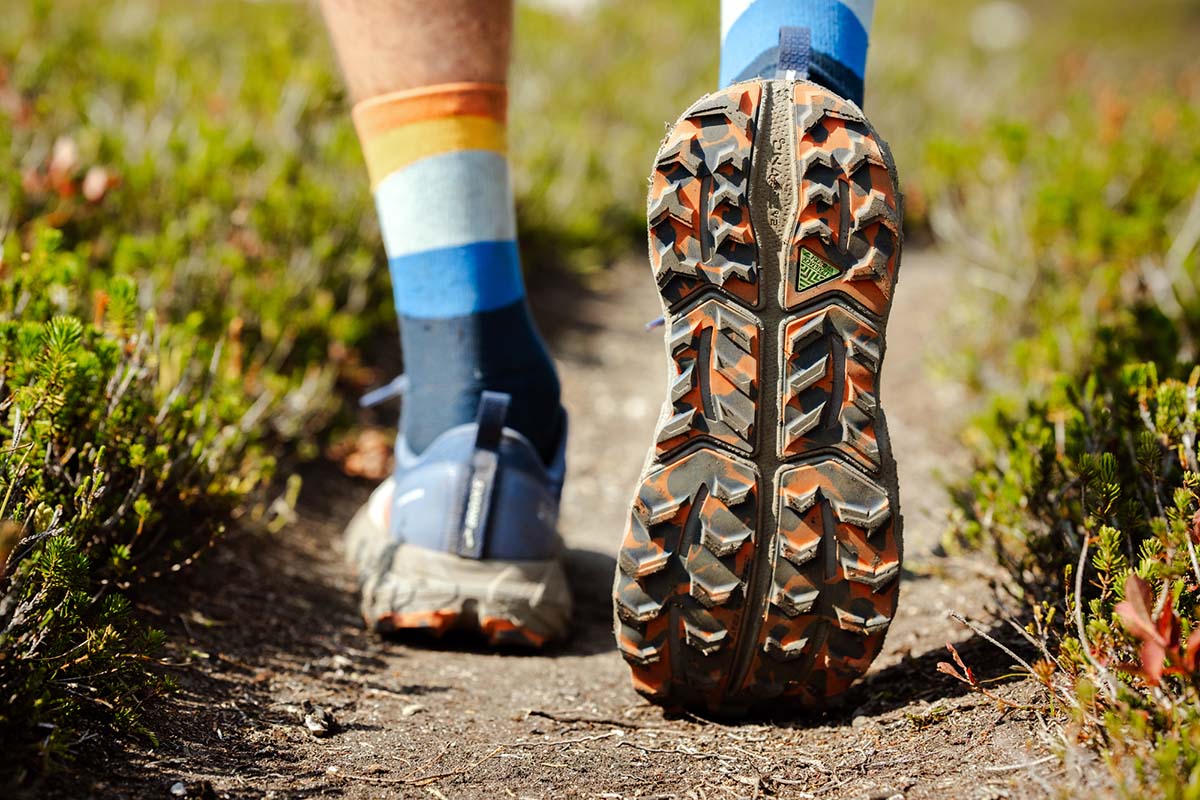
We put a high priority on weight when considering a trail running shoe. For 2025, our picks range from 1 pound 1.6 ounces for the Salomon Pulsar 4 to 1 pound 6.2 ounces for the men's Brooks Cascadia 18. Feathery designs will feel extremely light on your feet (great for speed), while heavier shoes feature maximum cushioning and are often more ruggedly built for off-trail exploring. Each design has compromises: Many lighter options lack overall protection and support, while designs like the Cascadia can be fairly cumbersome on easy trails. In general, the sweet spot is often right in the middle: You'll get enough protection and support for long distances without feeling sluggish.
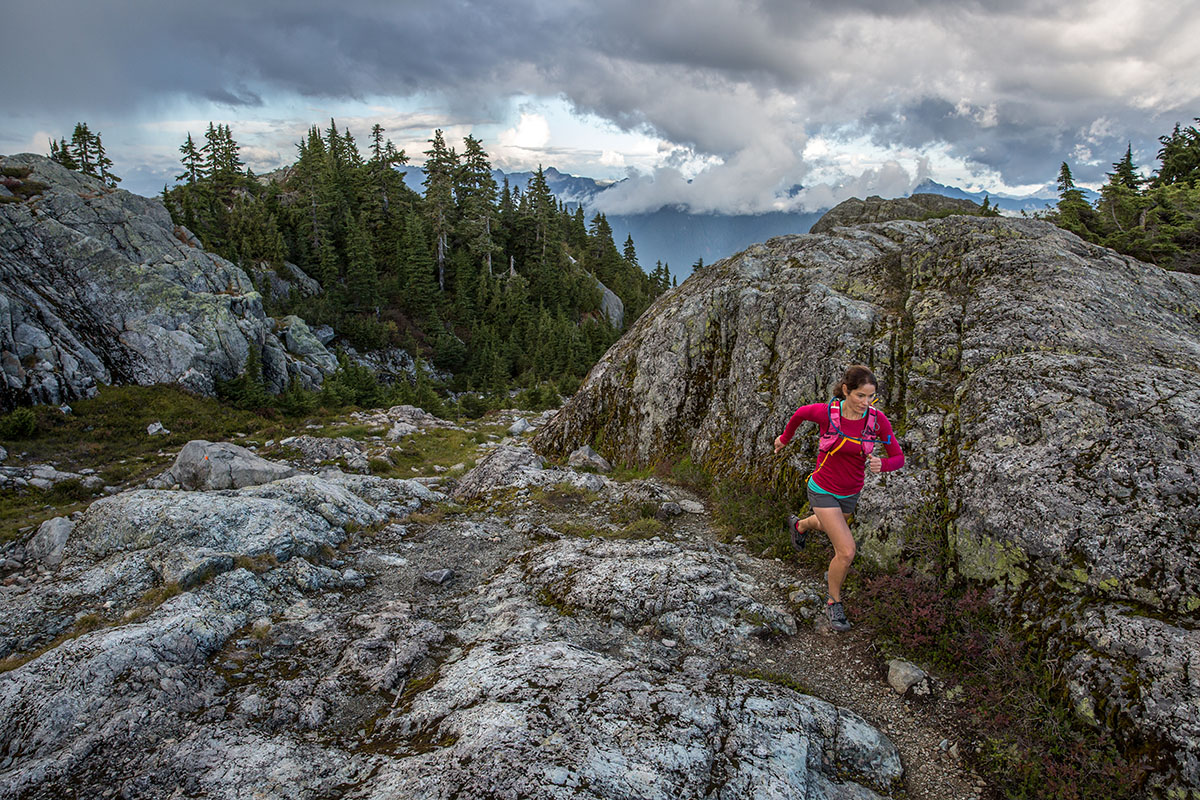
Not all trail running shoes are created equal, and traction is one of the places we see the most variation. In general, the level of grip provided will closely follow the intended trail usage. Shoes for easy trails feature a combination of outsole rubber and exposed midsole foam, which lends a lightweight, springy feel but suffers particularly on slippery rocks, roots, and mud. On the other hand, shoes built for rugged trails often have a full rubber outsole for excellent traction in mountainous terrain like snow, boulder hopping, and scree. All-rounders fall somewhere in between and are a great middle-ground option for most trail running objectives.
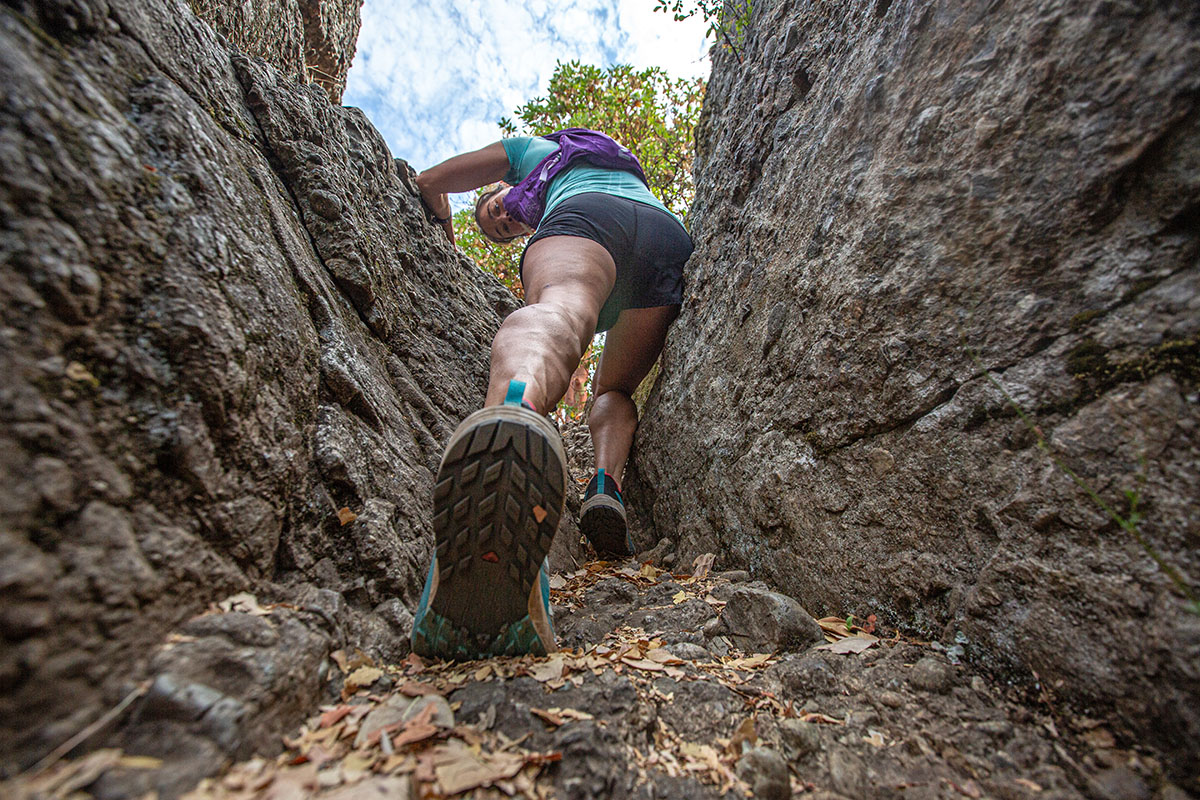
Looking closer at the nitty gritty of traction, an outsole’s rubber compound, tread depth, and tread pattern all play a role in maximizing grip. Shoes that have sticky, approach-shoe-like rubber, like the La Sportiva Bushido III excel on rock, while others that have a softer and more pliable feel often do better in mud. Secondly, tread depth (lug depth as defined by millimeters) isn’t listed by all manufacturers, but you can get a good idea of the size by looking at an image of the sole. Tall lugs like you’ll find on the Salomon Speedcross 6 provide excellent bite in loose ground, but the raised profile has a negative impact on stability. Finally, the tread design should be considered: Widely spaced, tall lugs with a soft compound will outperform tightly spaced, short lugs, and sticky rubber in mud, and the reverse is typically true over rock or hardpack.

We often refer to cushioning as “stack height:" the measured height from where the foot sits inside the shoe to the ground. Trail running models range from minimalist to heavily cushioned, with most generalist options falling somewhere in the middle. Minimalist designs with low-profile midsole foam can be extremely nimble and provide a close groundfeel, but we've experienced sore feet after long days in shoes with less than 20 millimeters of stack height. Maximum-cushioned shoes are the most popular these days, with offerings including 40 millimeters under the heel in the Speedgoat 6 and 38.5 millimeters in the On Cloudultra Pro. These are incredibly well cushioned for comfort over long distances, but you naturally lose groundfeel and stability. Midrange shoes, like the 28-millimeter Saucony Peregrine 15 are a good middle ground for protection without losing energy return and balance.
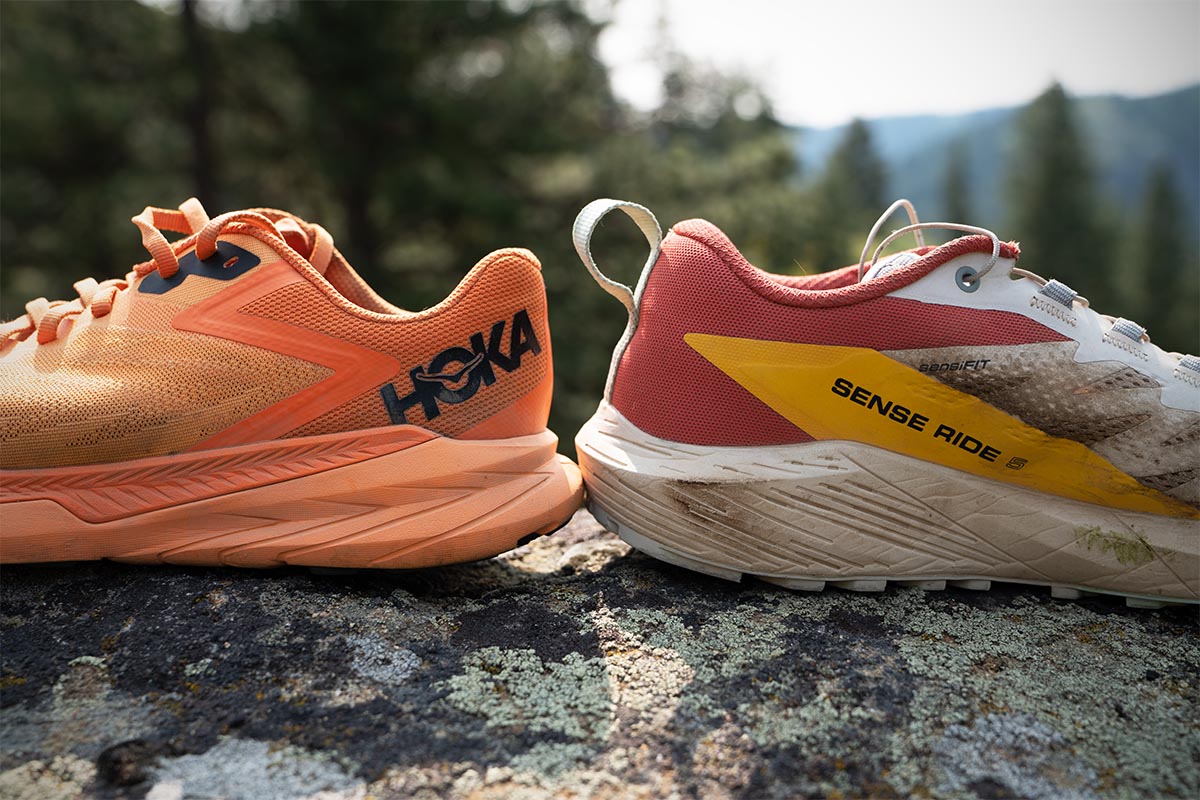
As the name indicates, the heel-to-toe drop is the difference in shoe height from the heel to toe. This spec was barely on the radar of folks outside the hardcore running community until the zero-drop fad hit a few years ago. Many all-rounder shoes have a drop in the range of 4 to 8 millimeters, which can work well for both heel and midfoot strikers. True zero-drop shoes have a 0-millimeter difference, encouraging a mid- or forefoot landing point. And many models for rugged trails have the most dramatic drops, often 8 to 10 millimeters.
We believe heel-toe drop is a matter of comfort and personal preference. Many people like a moderate drop in their trail running shoes, while others prefer a zero-drop design like the Altra Lone Peak. The general trend is toward lower-drop shoes, though performance and injury-prevention claims are hotly debated. No matter what you choose, it's important to avoid major changes to your shoe design without easing into it (mileage-wise). This will reduce the chance of injury and ensure that it's the right choice for you.
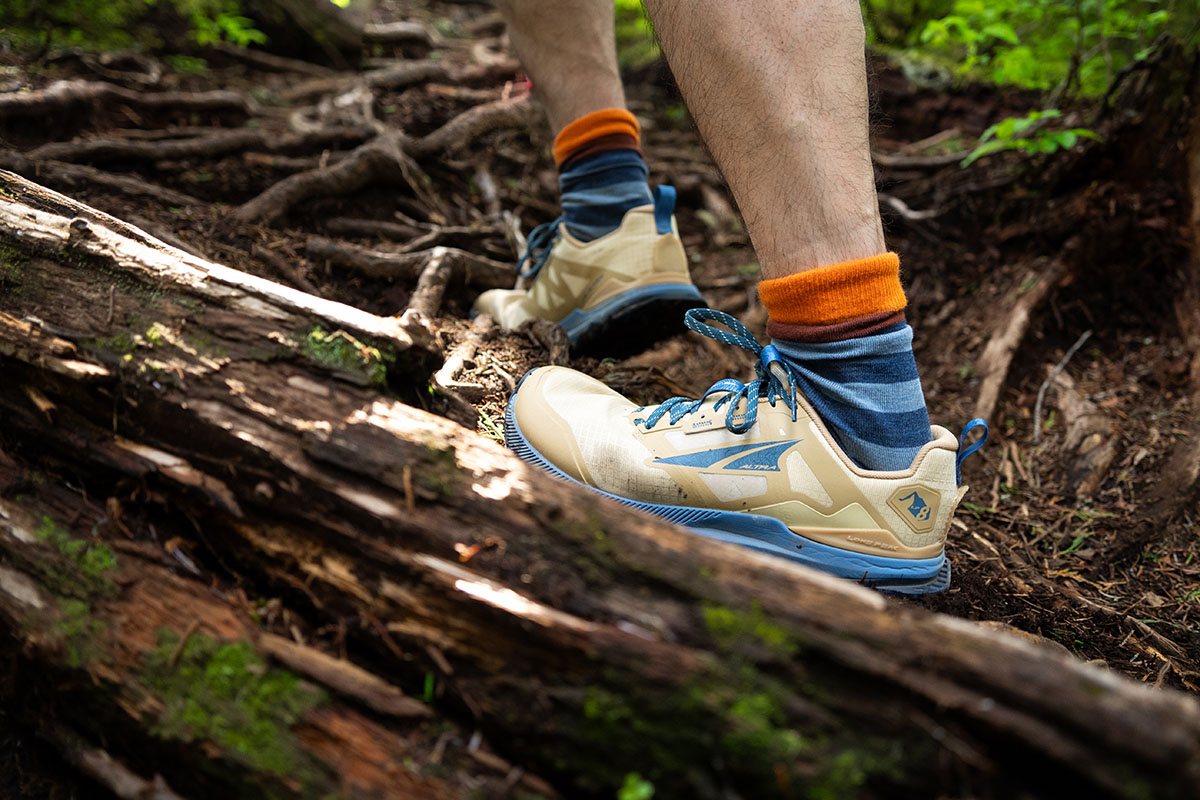
Trying to move fast over rough terrain in a pair of lightweight low-top shoes may seem like asking for an injury, but today’s trail running shoes offer a stable ride quite resistant to ankle rolls. This starts with a solid platform that's wide and rigid enough to sustain hard impacts on uneven ground—a great example is the Topo Athletic Mtn Racer 4. The chassis—the perimeter of the base of the shoe—is often beefed up to create that solid base. In addition, some shoes include a shank, a semi-rigid piece of plastic or nylon between the midsole and outsole for added stiffness. Finally, some manufacturers create reinforced overlays around the heel cup for added structure and rollover protection. The relative stiffness and stability of a shoe often correlates with its intended use: A mountain-oriented shoe like the La Sportiva Bushido III is stiffer and has more of a structure, while lighter trail runners like the Brooks Catamount still provide protection, but have fewer reinforcements and overlays.
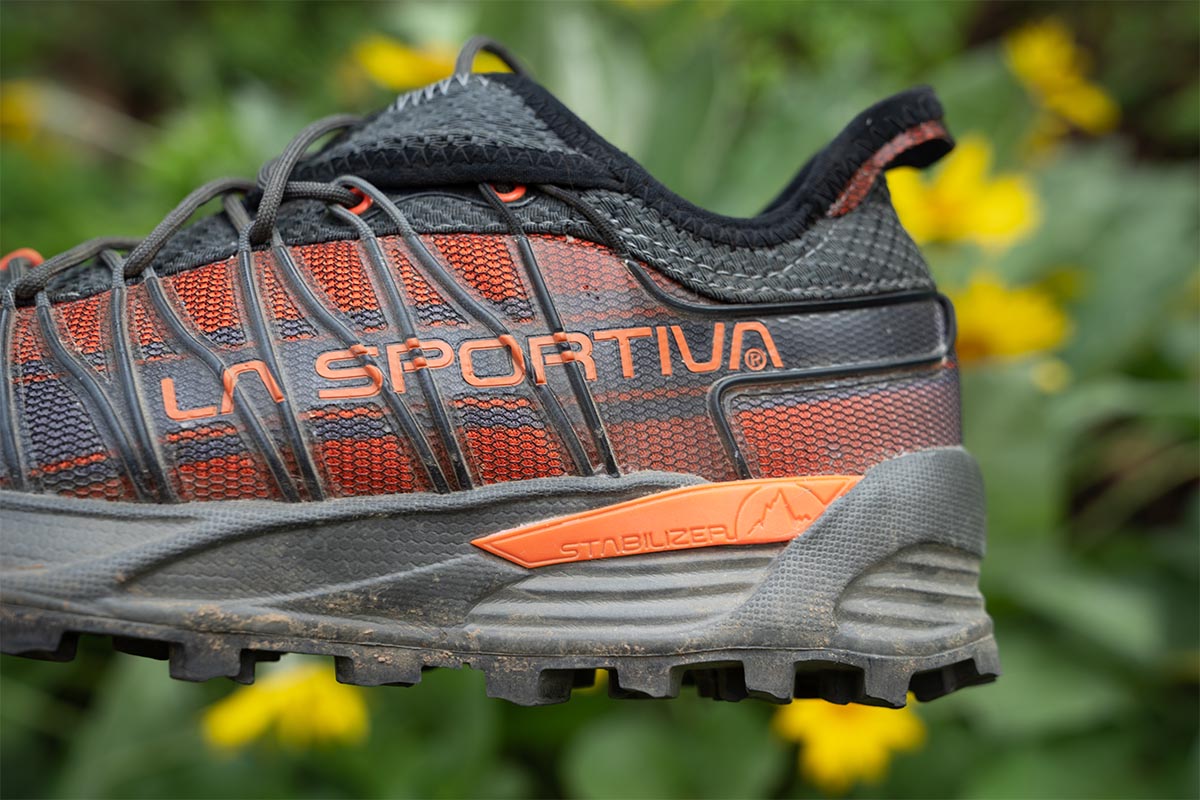
Rain and wet conditions don’t stop most trail runners from getting out, but wet feet can be a big reason for going home early. For this reason, many of the shoes above are offered in waterproof versions, which feature a waterproof and breathable membrane (usually Gore-Tex) between the outer fabric and the shoe’s inner lining. These shoes are generally a few ounces heavier per pair and $15 to $40 more, but the waterproofing is very effective and especially makes sense in cold weather, when wet feet become cold feet in a hurry.
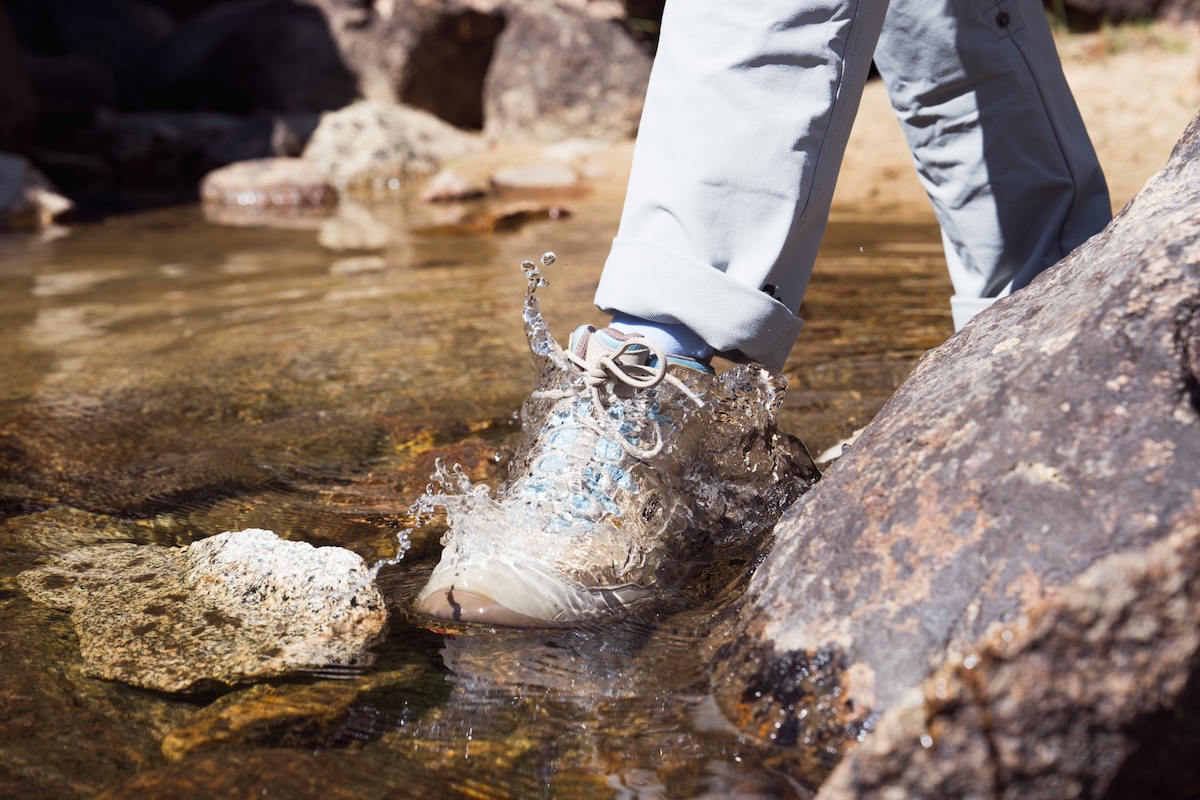
That said, we’re not huge fans of waterproof trail running shoes for a few reasons. Waterproof membranes have a significant impact on breathability, creating a ripe situation for clammy feet. What’s more, drying time suffers, with no way for water (or sweat) to leave once it's inside. Further, while they guard against low-lying puddles and streams, waterproof shoes do nothing to prevent water from entering at the ankle. In the end, we can see the appeal for shoulder seasons or winter, but for most runners, the tradeoffs simply aren’t worth it. And if you want to add waterproof protection without a brand new shoe, you can waterproof socks like these from SealSkinz, which are easy to take off and stow in your pack during stretches of dry trail. For more on this topic, check out our article: Do You Need Waterproof Hiking Shoes? You can also see our top waterproof hiking shoes, which include plenty of trail running shoes.
.jpg)
A sweaty foot is an uncomfortable foot, which is the last thing you want to be thinking about while wheezing your way up a steep climb. As such, the ventilating ability of a shoe is one of the most important factors for runners. Nylon mesh is a common material used in trail running shoes for increased breathability, and to retain durability, many manufacturers use a combination of a tight weave and thin fabric to resist tears and keep air flowing. Some are more accomplished than others, and we recommend looking for shoes with tight mesh and few overlays, like the Salomon Pulsar 4 or Hoka Speedgoat, for maximum breathability.
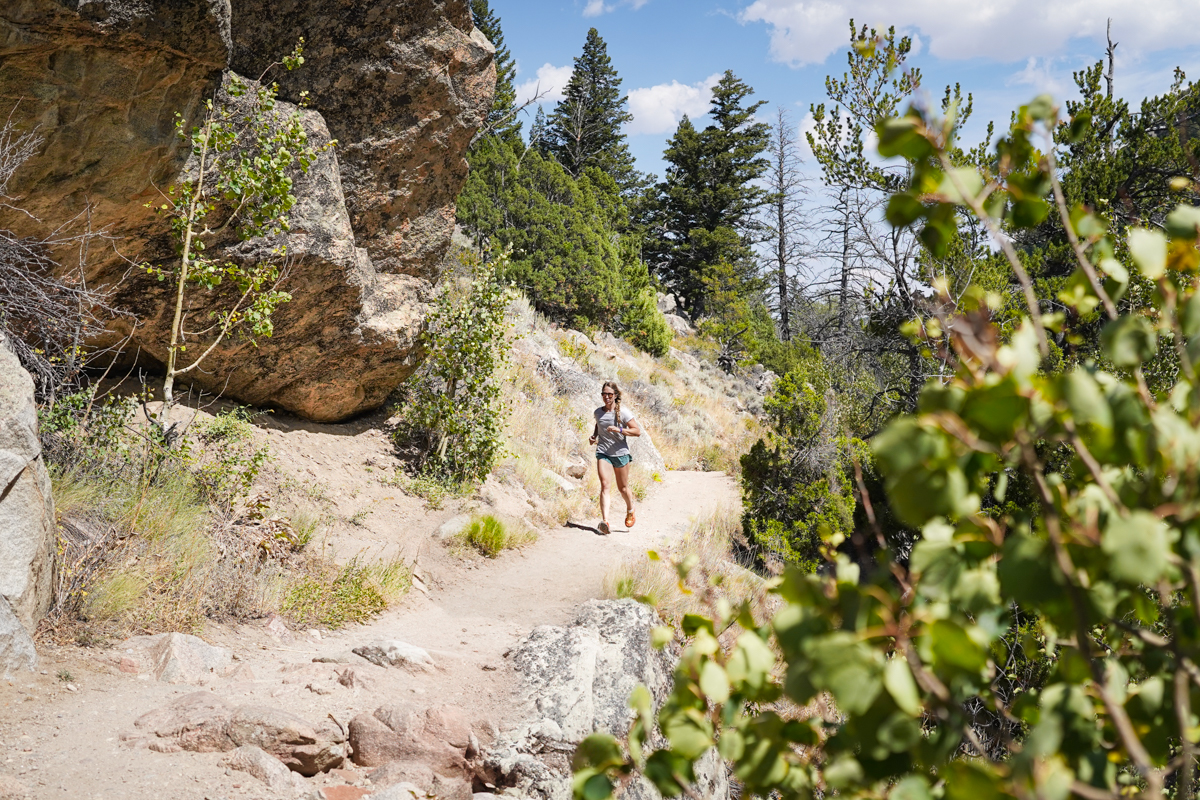
Trail running naturally puts you in terrain more challenging and potentially hazardous than what you’ll find around town, and we love any added toe protection from your shoe’s construction. Trail running shoes almost always offer this, usually in the form of a rubber toe guard or cap capable of absorbing direct hits. Because of the lightweight intent of a trail runner, the toe protection isn’t as substantial as a hiking shoe, but it should prevent your toes from turning black and blue should you accidentally kick a rock or root on the trail.
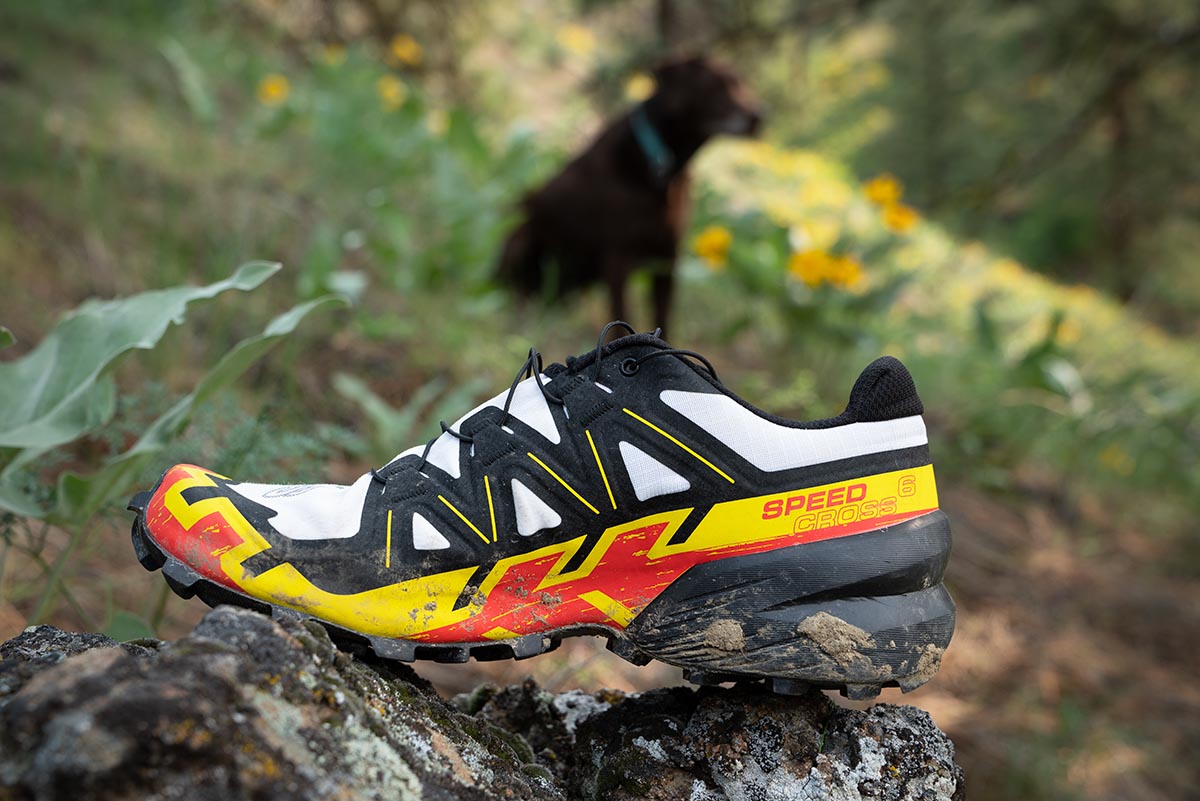
Much in the same way that a protective toe cap isolates you from a sharp rock or other trail debris, lightweight rock plates are inserted between the midsole and outsole on many trail shoes. These plates vary in thickness, coverage, and materials, ranging from thin and flexible ESS foam under the ball of the foot to a stiff TPU shank. How much protection is needed depends on personal preference and the terrain you'll be running over (more miles on rough trails will merit burlier protection), but overall, we find rock plates to be a great feature. They’re unobtrusive, keep foot soreness to a minimum, and only add a small amount of weight.
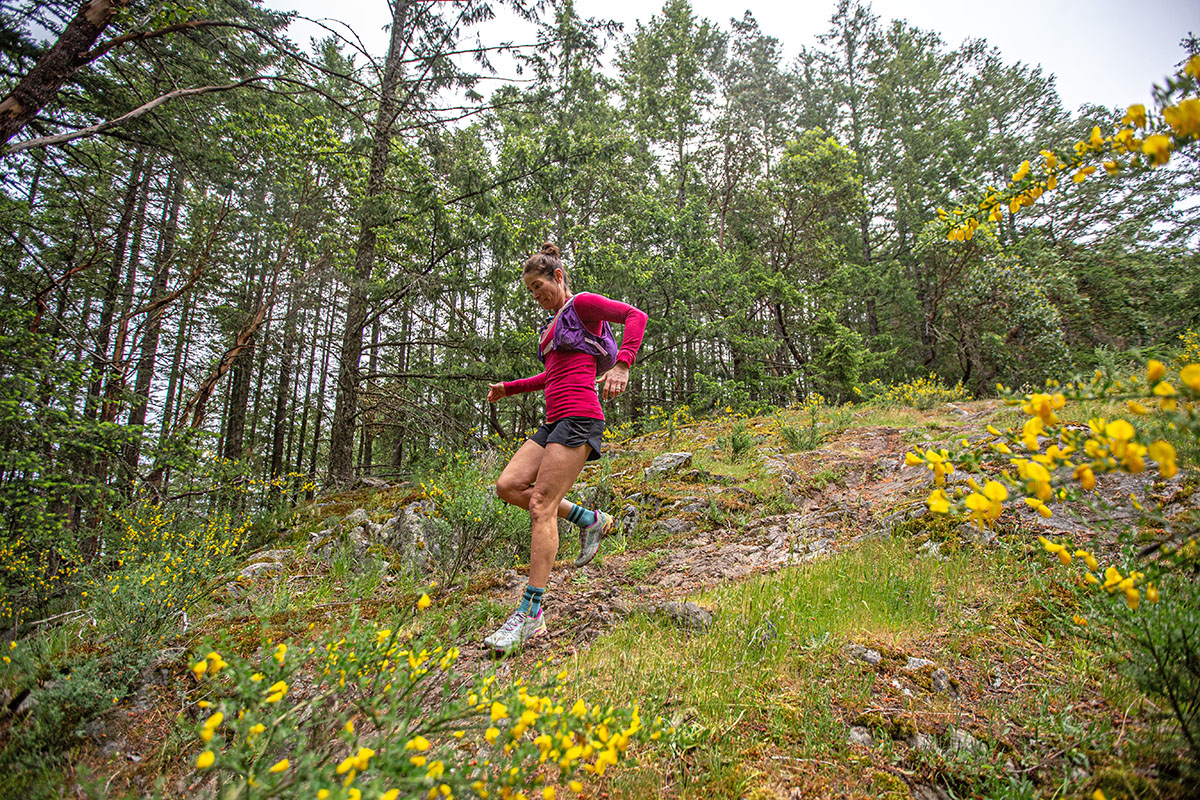
Laces are easy to overlook but play a fundamental role in comfort. Most shoes use a standard lace-up method, but brands like Salomon are doing things differently with a single-pull “Quicklace” system on their trail runners. We love this design on the Speedcross 6, Pulsar 4, and S/Lab Ultra for its ease of use and speed. It only requires a single pull, and then you can tuck away the excess laces and forget about them. We’ve found that the laces hold securely—better than some traditional sets in fact. There is a potential downside, though: For those with finicky feet who need to customize the fit around certain parts of their feet, there isn’t really a solution with quick laces—they will fit equally tight all around. Accordingly, we recommend avoiding them if you often struggle to achieve a good fit.
.jpg)
Mountain running is experiencing a huge growth spurt, with more and more enthusiasts ditching heavy overnight gear for a pair of running shoes and a light pack. By our definition, this style of running takes you off trail and into cross-country zones, where you might encounter anything from technical rock climbing and talus or boulder fields to glacier travel and steep snow—think ridge scrambling in the Rockies or peak bagging in the North Cascades. And you’ll need just the right footwear to tackle this complex terrain: A shoe that combines the light weight and comfort of a trail runner with the stability, grip, and durability of an approach or hiking shoe. By another definition, mountain running is a USATF sanctioned sport in which elite runners race on short and steep courses. This is very different from the form of mountain running and requires a different skillset and a focus on much lighter footwear.
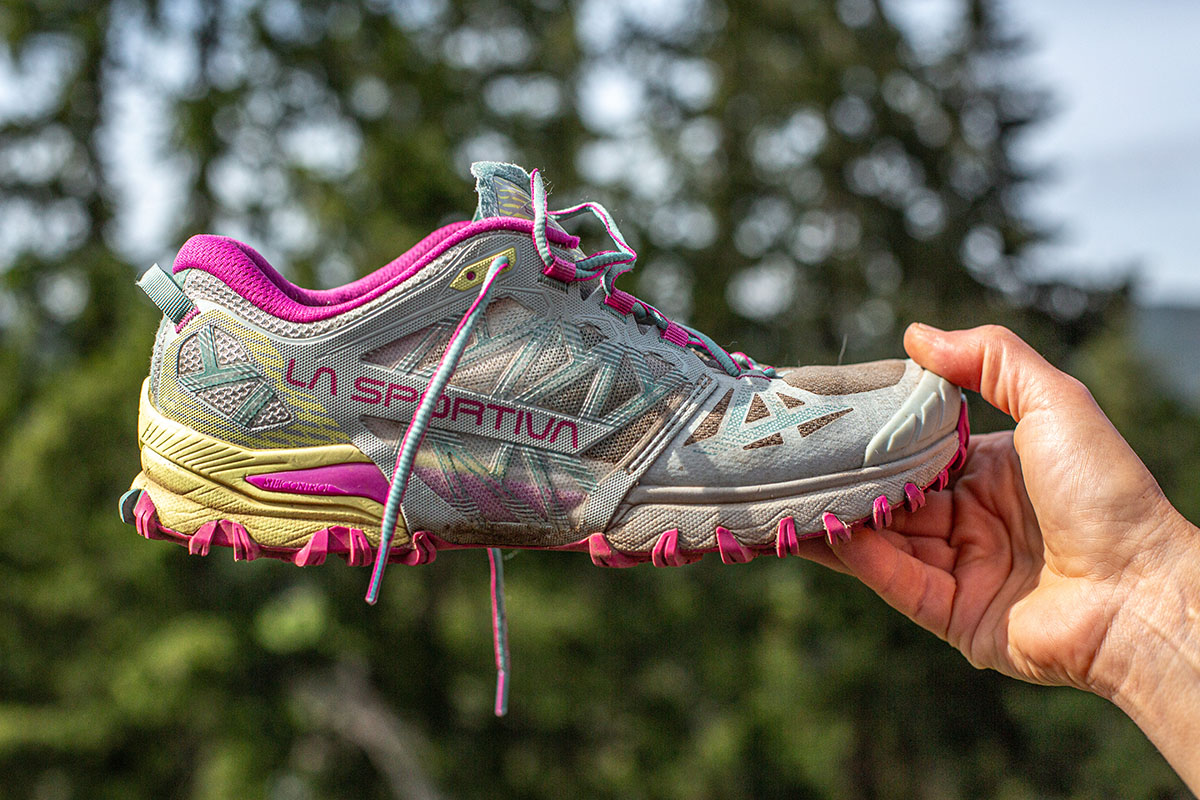
Fortunately, a whole new class of mountain running-specific shoes has emerged recently, engineered especially for off-trail trickery. La Sportiva leads the field here, but designs from brands like Dynafit, Salomon, and Scarpa come in close behind (some of our favorites include the La Sportiva Bushido III, and Scarpa Ribelle Run). Within this category, look for sticky rubber outsoles (Megagrip and FriXion are common compounds) with shallow lugs and a smooth patch near the toe for climbing performance. Many will feature a lower, more planted feel for stability on off-camber terrain, aided by moderate-to-light cushioning in the midsole. Finally, they’re relatively stiff and have durable and protective uppers (we often strap crampons or microspikes to our mountain running shoes). For more, check out our editor's picks for the best mountain running gear.
If you’re anything like us, your daily runs leave from your front door and include a combination of pavement and trail. That’s all well and good, until you consider that most trail running shoes are not designed to run on pavement. With full rubber soles, firm midsoles, and more protective uppers, they’ll feel overbuilt and heavy. What’s more, they often use softer rubber compounds that will wear out prematurely if subjected to a lot of road running.
A few hybrid designs toe the line between the two worlds, including the Hoka Challenger 7, Topo Athletic MT-5, and Altra Outroad 3, but their trail performance is so middling that we don’t include them in our main guide. However, looking at our picks, there are a few trail-ready models that stand out as being able to handle the road better than most, including the Nike Pegasus Trail 5, Scarpa Golden Gate 2 ATR, and Brooks Divide 5. These shoes often feature some of the same components as road running shoes, including soft midsoles and airy mesh uppers. Don’t expect them to be particularly great performers on pavement (the trail-ready rubber outsole will feel cumbersome), but they’ll get you from your doorstep to the trail—and back—better than most.

Trail running shoes have become wildly popular for everyone from day hikers and fastpackers all the way to thru-hikers. And it makes sense: With a lightweight and flexible build that doesn't skimp on traction, you can cover more ground with less effort. Further, most day hikers and thru-hikers keep pack weight to a minimum, so there’s less need for the stability and ankle support of a sturdy shoe or boot. In fact, we’ve spoken to some PCT thru-hikers who made the switch from boots to trail runners mid-trip, and they’ve had nothing but good things to say about their levels of comfort and nimble feel—provided they kept their pack weight down. The Brooks Cascadia has long defined this category of crossover trail shoes, and we see a lot of hikers wearing the Hoka Speedgoat 6 and Altra Lone Peak 9. For reference, one editor who hiked the Triple Crown had nothing but rave reviews for both the Lone Peak and Speedgoat after thousands of miles of hard trail. Once he found the joy of hiking in trail runners, he never looked back.
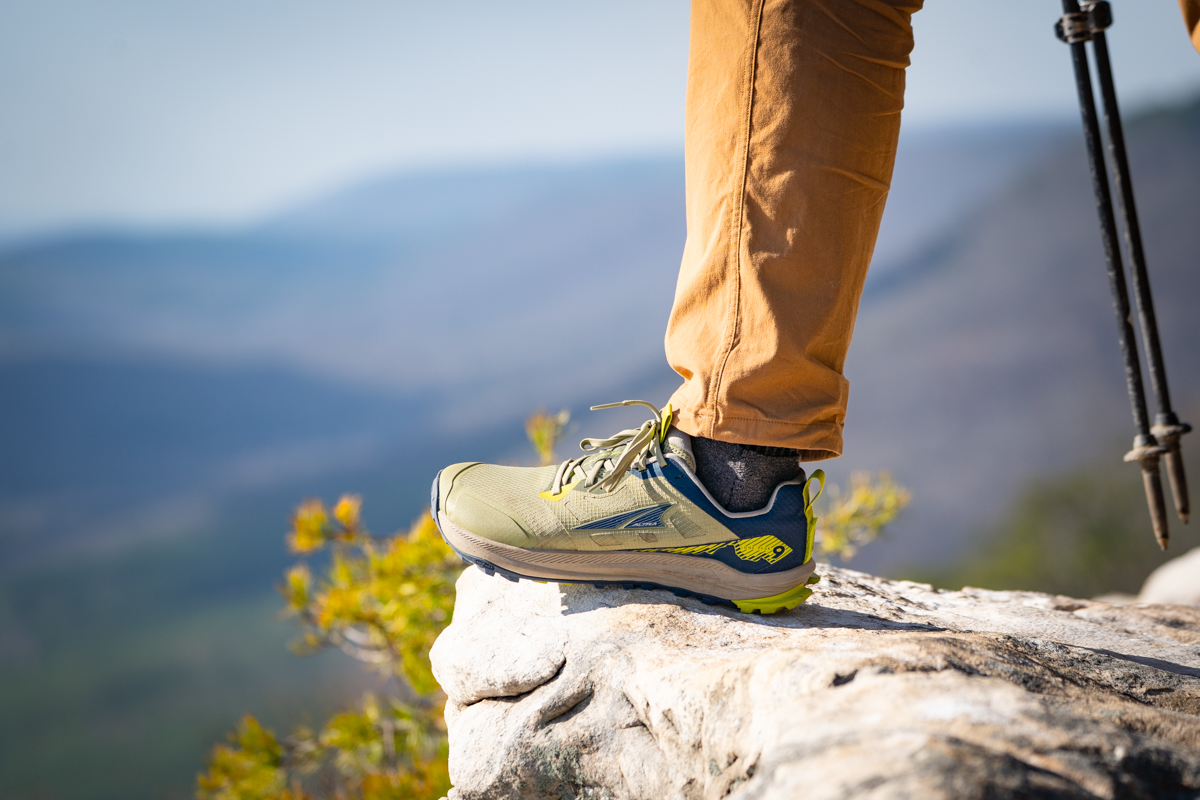
But there are a number of obvious issues. One is durability. It’s unlikely you’ll get as many miles out of your trail runners as you would a lightweight hiking shoe or full-on hiking boot, which are designed to handle more use and abuse. Second, with minimal materials and bulk, a trail runner simply does not offer the same amount of protection as beefier hiking footwear, especially those with generous rubber rands and leather uppers. Finally, we don’t recommend trail running shoes for heavy loads or particularly rugged terrain, when you’ll want a more supportive option. But despite these potential downsides, trail runners seem to be here to stay as a popular hiking and backpacking option, and models like the Lone Peak and Speedgoats offer more durability over the long haul than one might imagine. If you want to take a deeper dive into the available options, check out our article on Hiking Shoes vs. Trail Runners.
Back to Our Trail Running Shoe Picks Back to Our Trail Runner Comparison Table